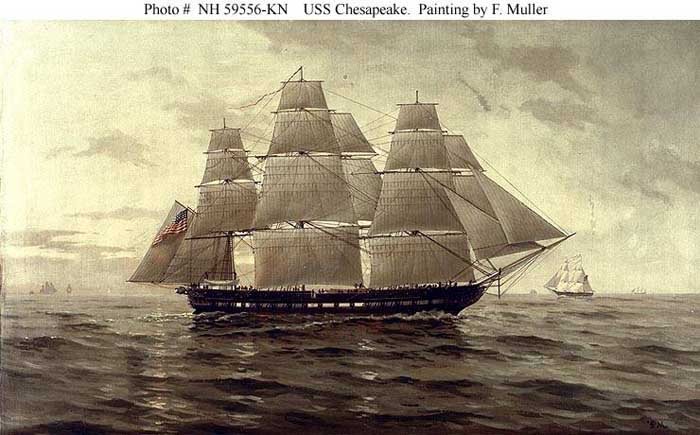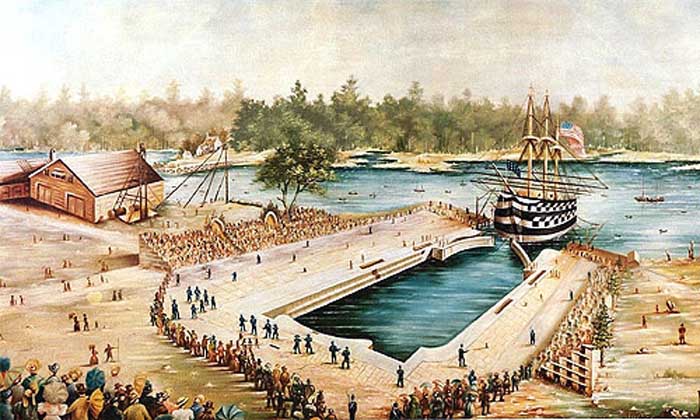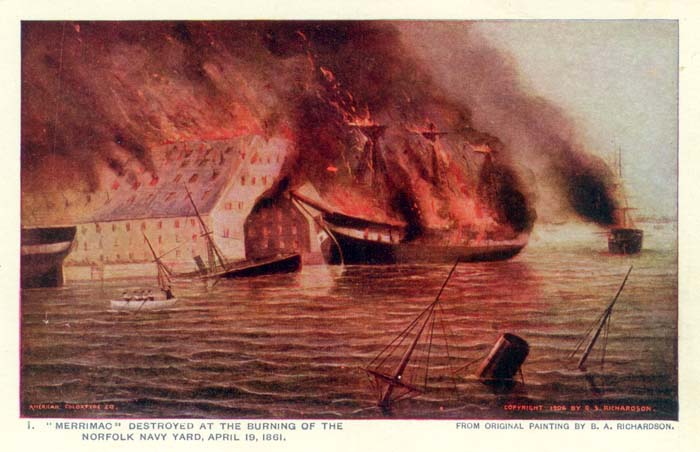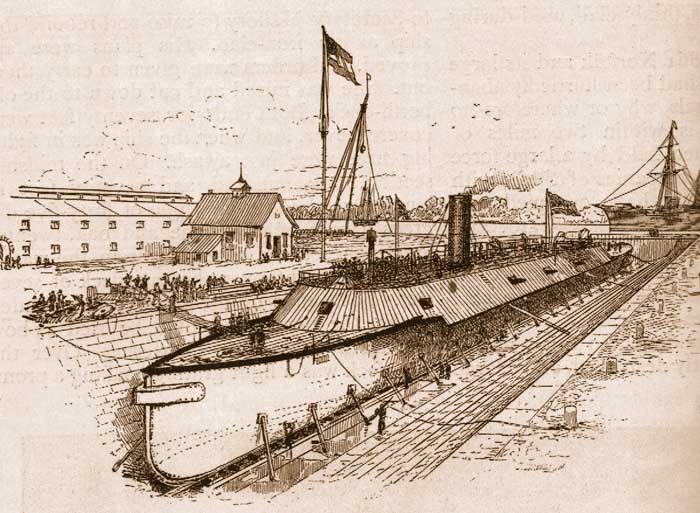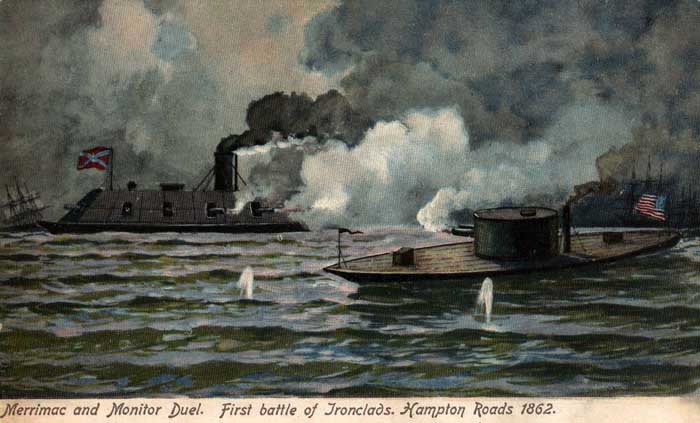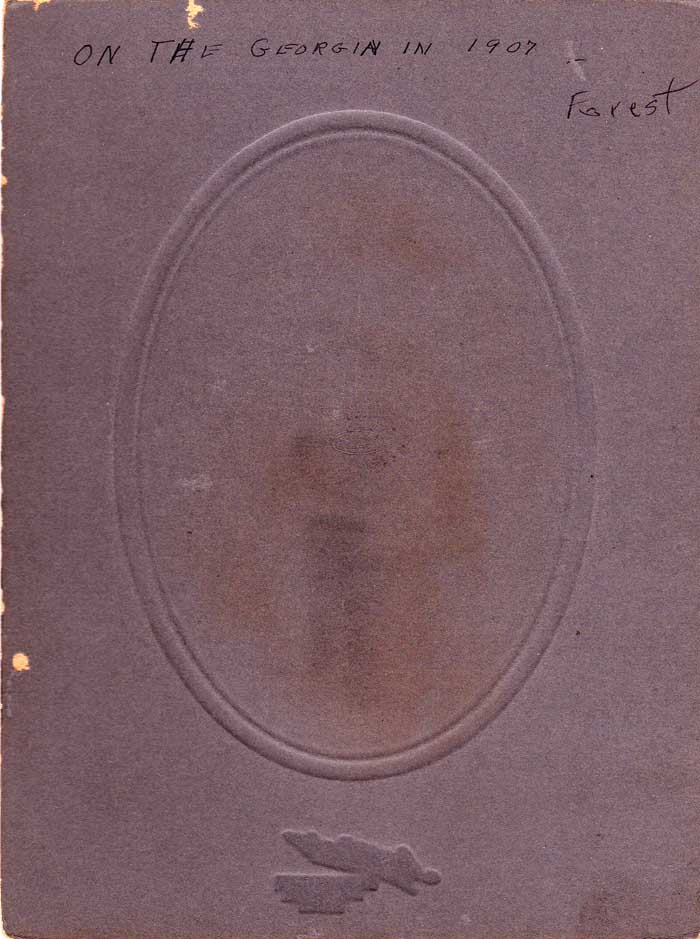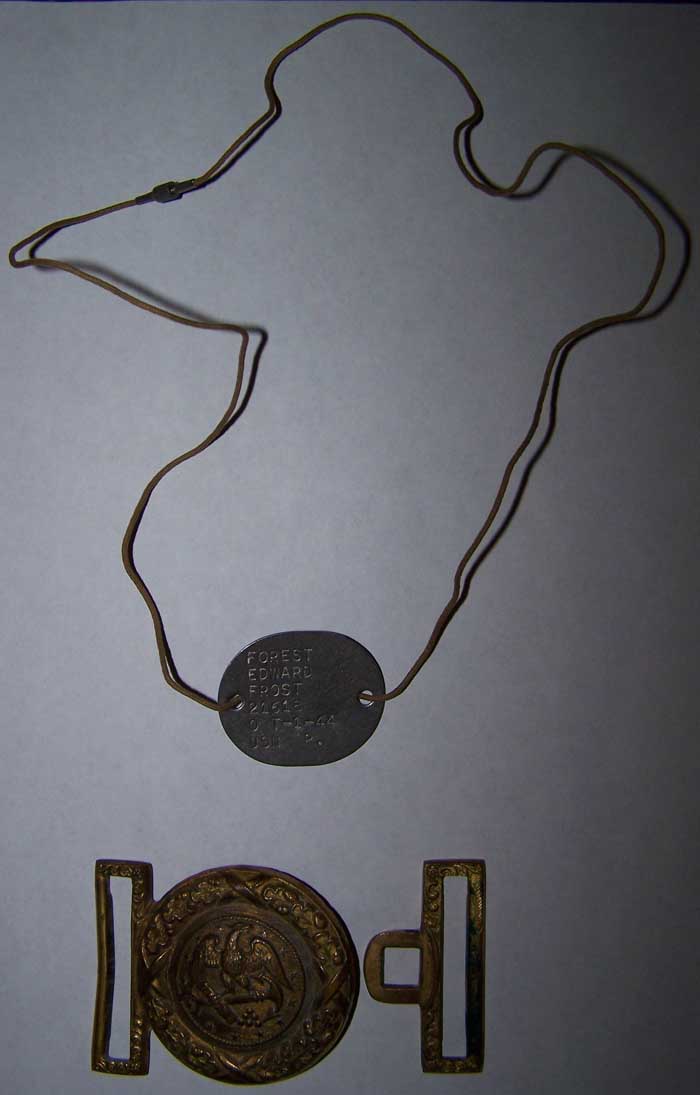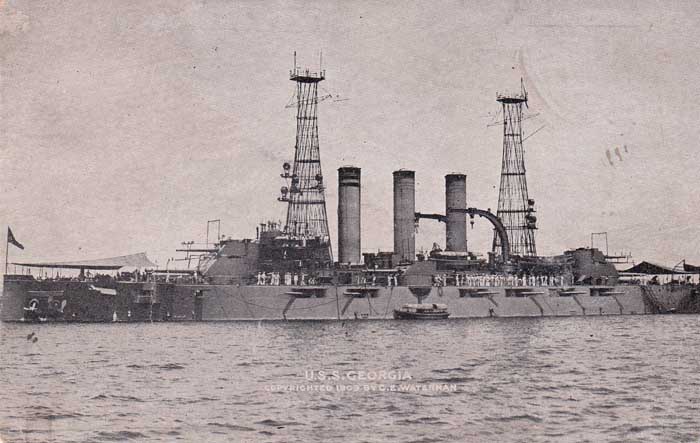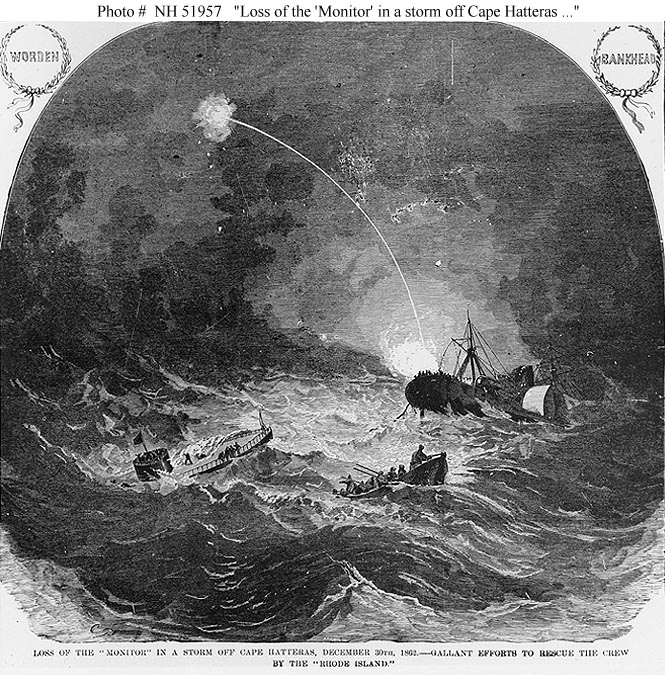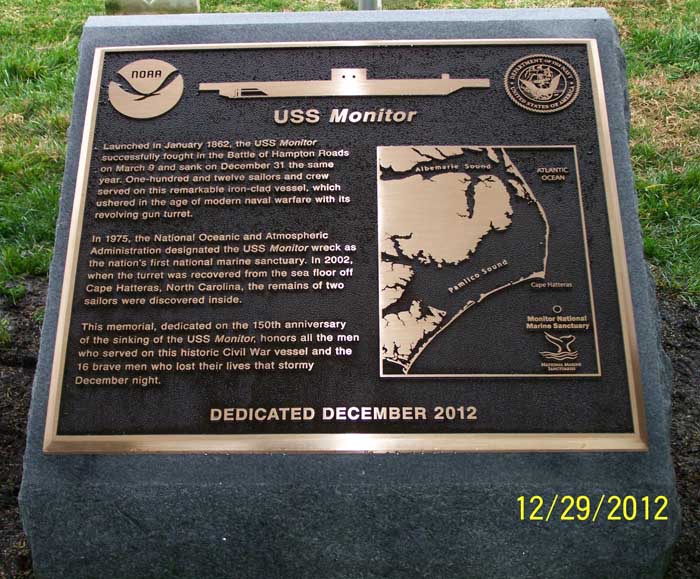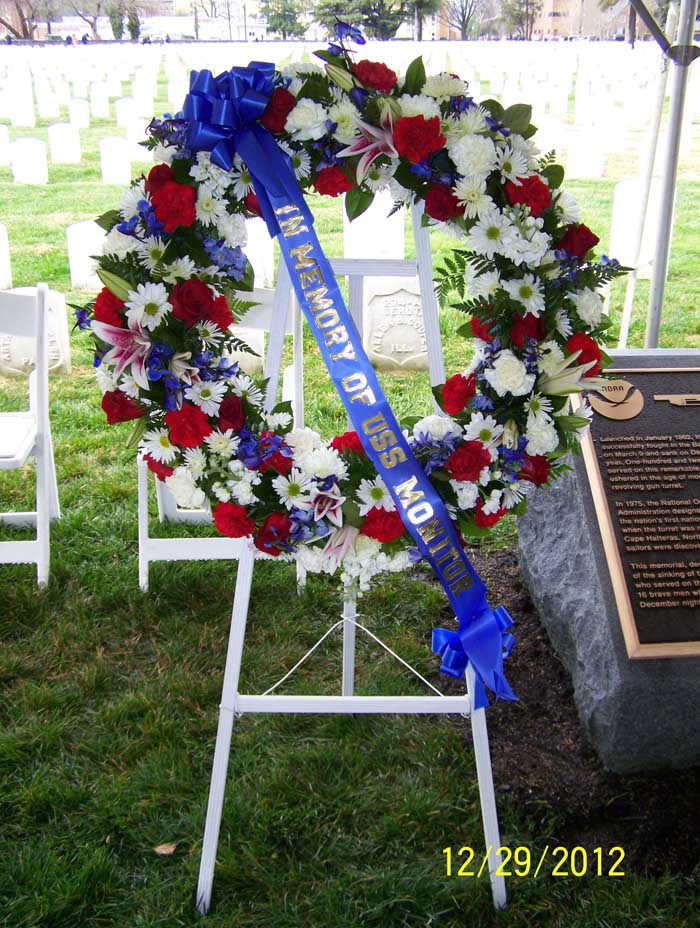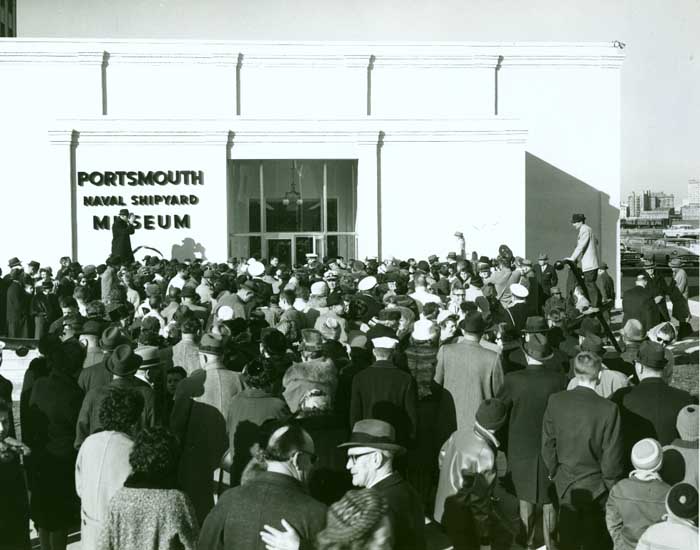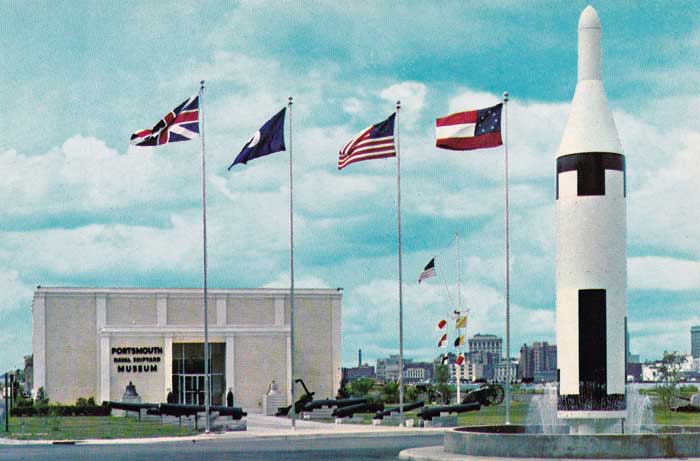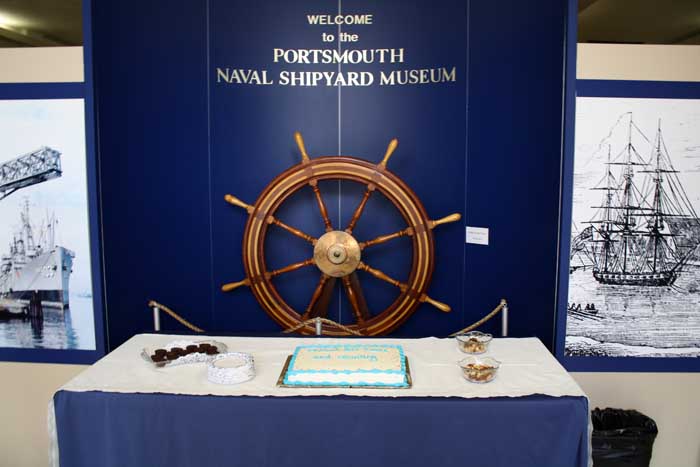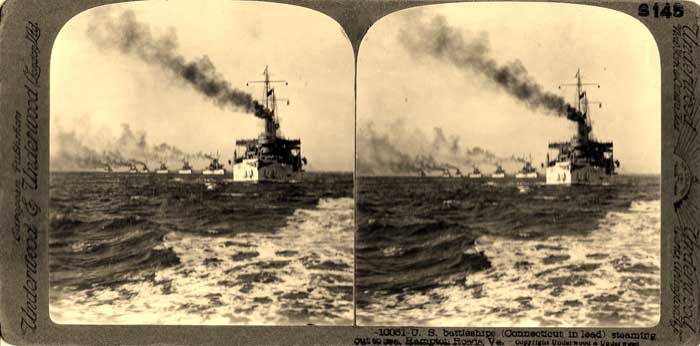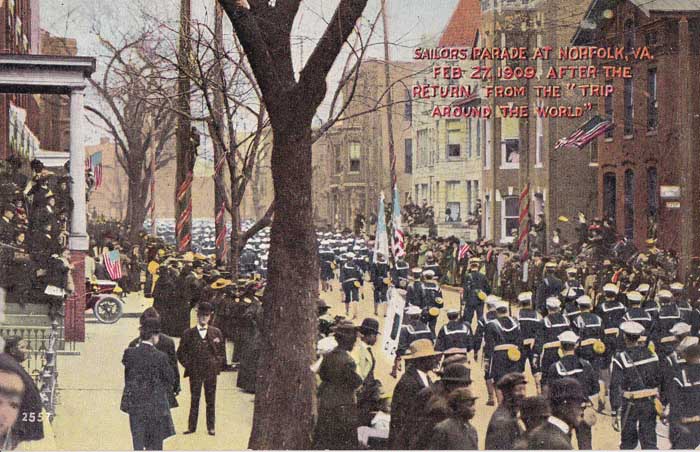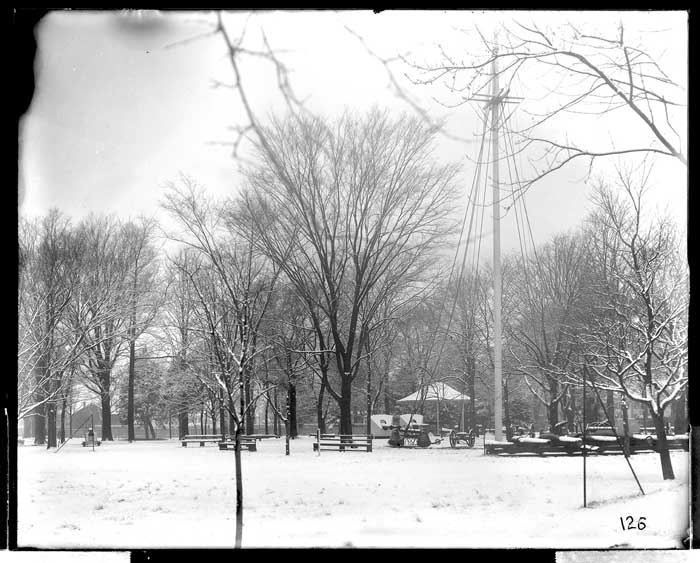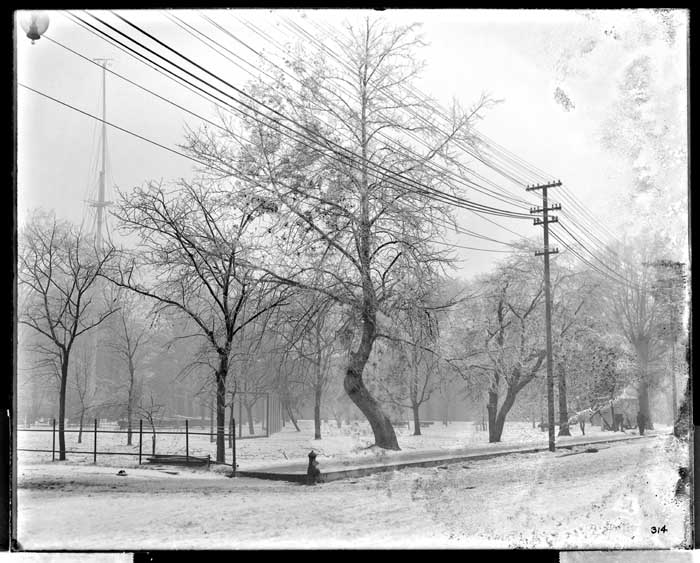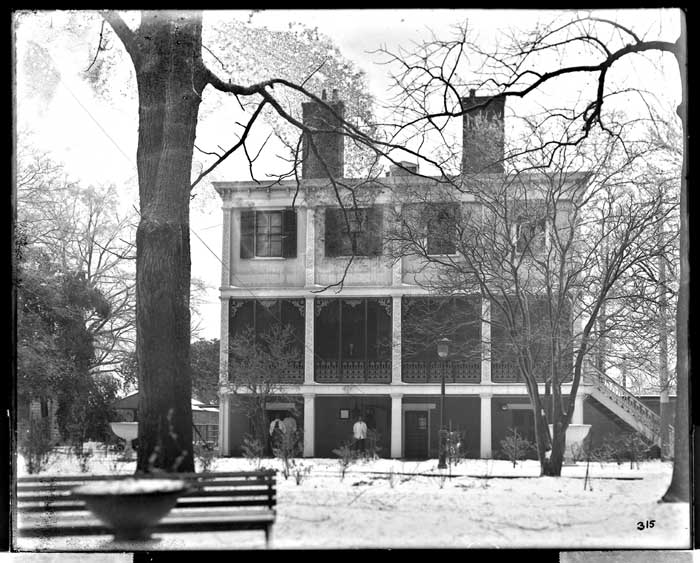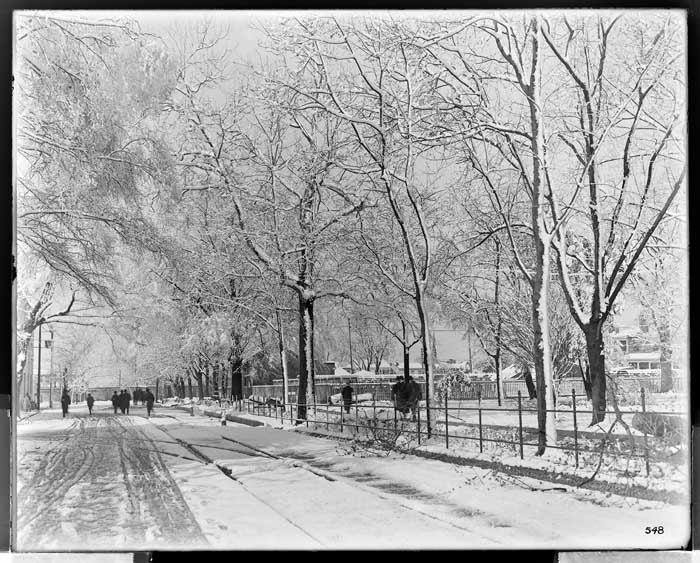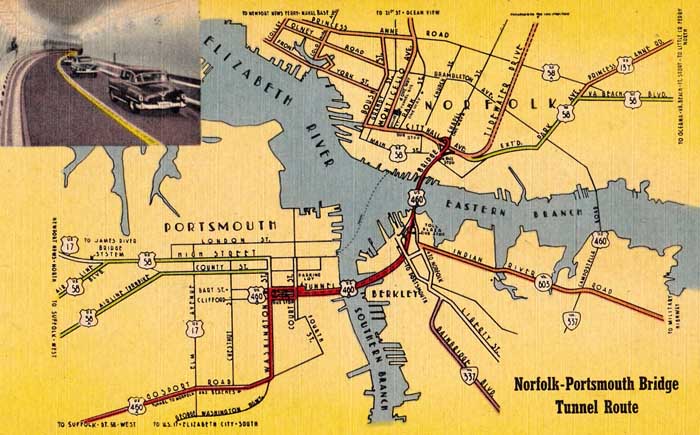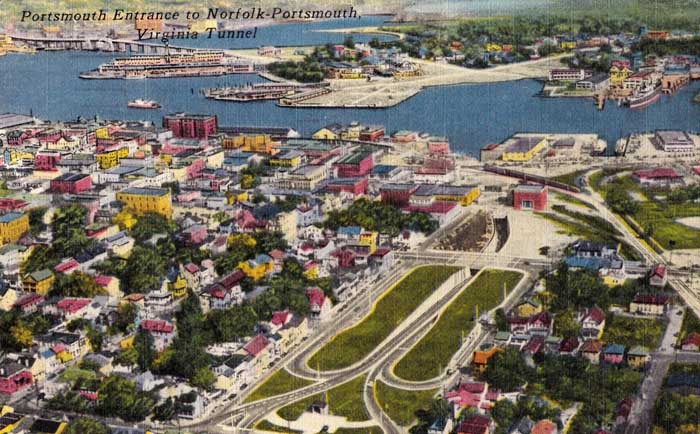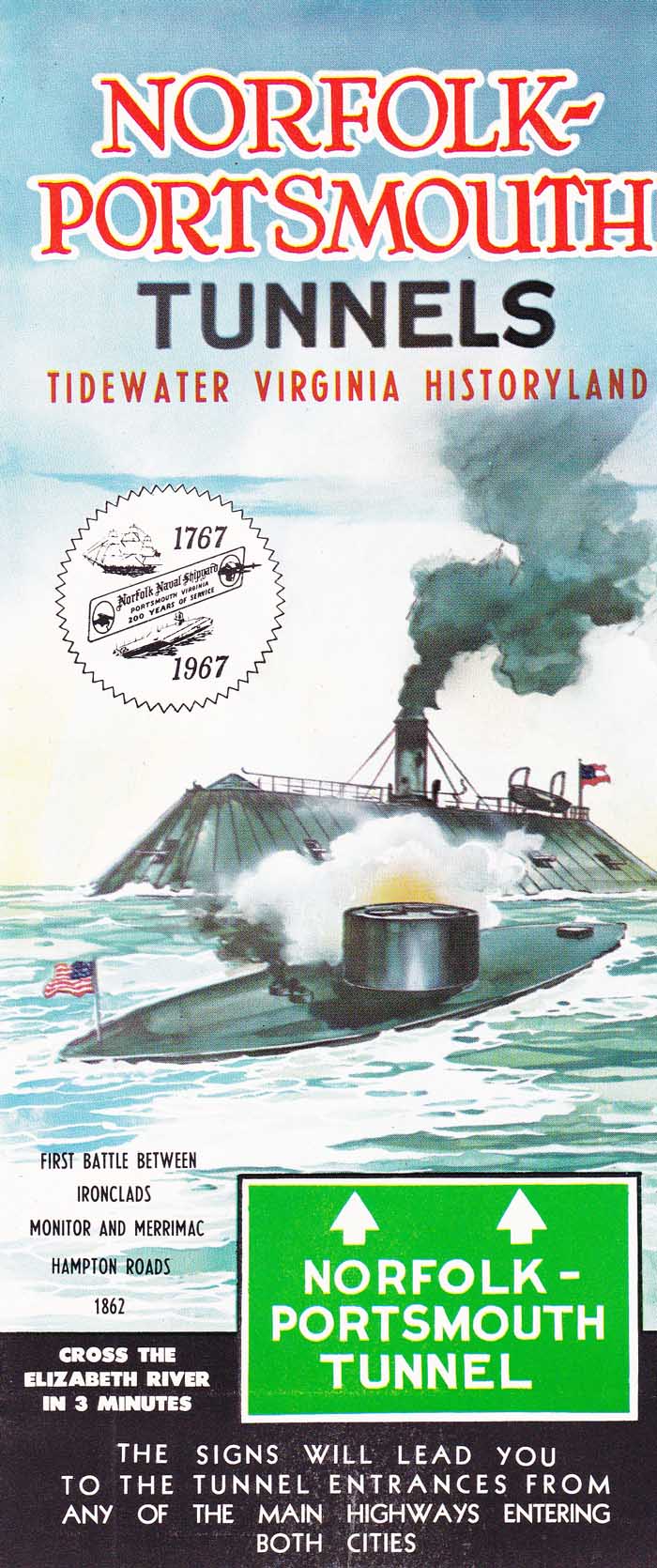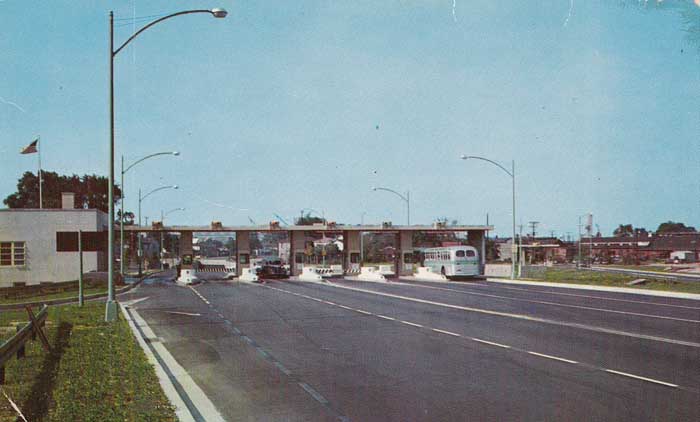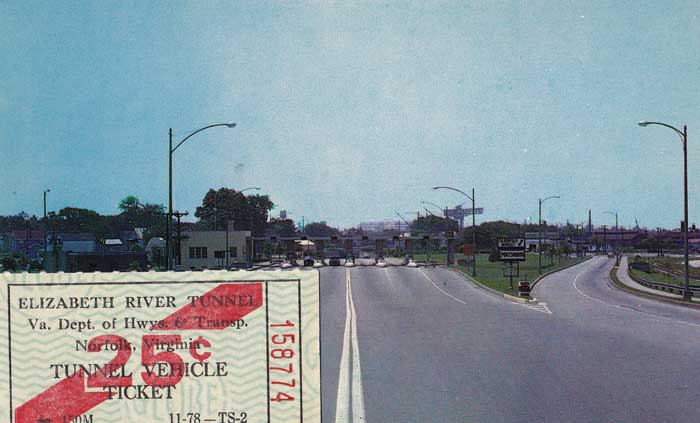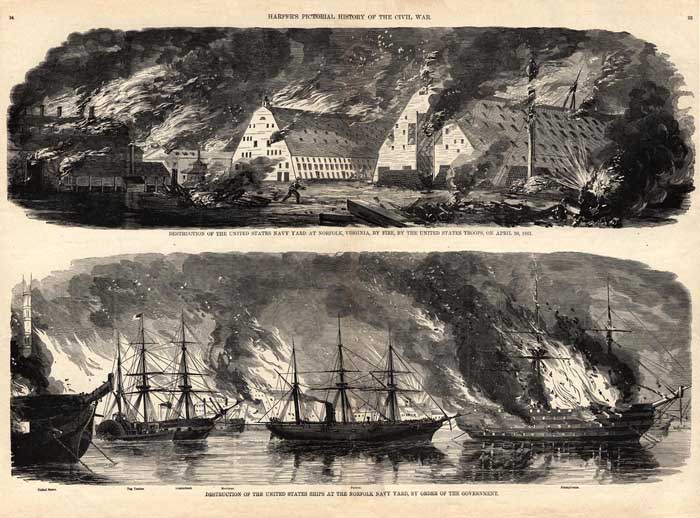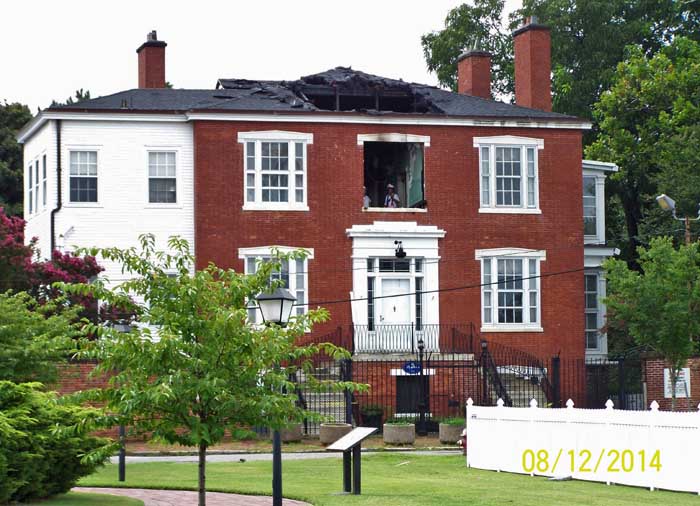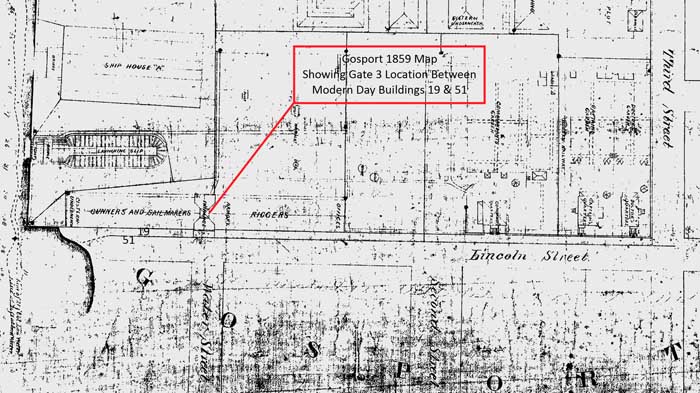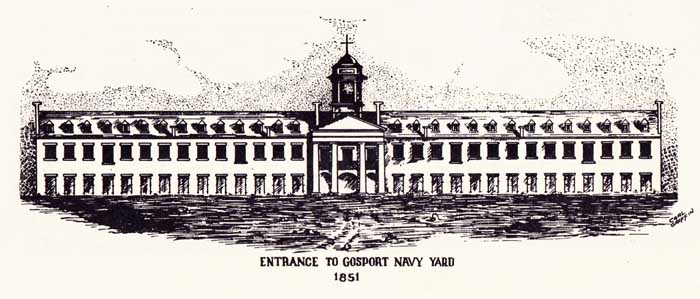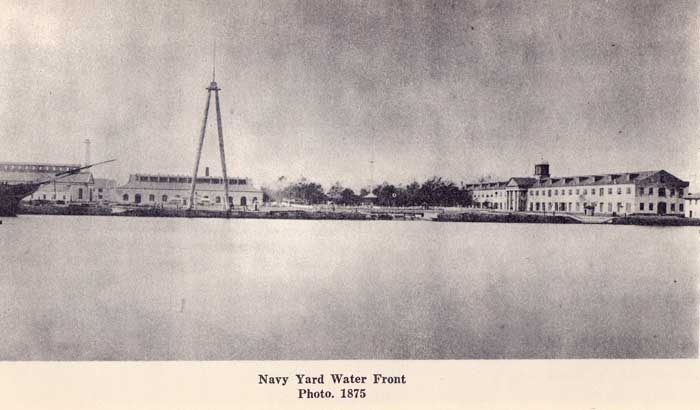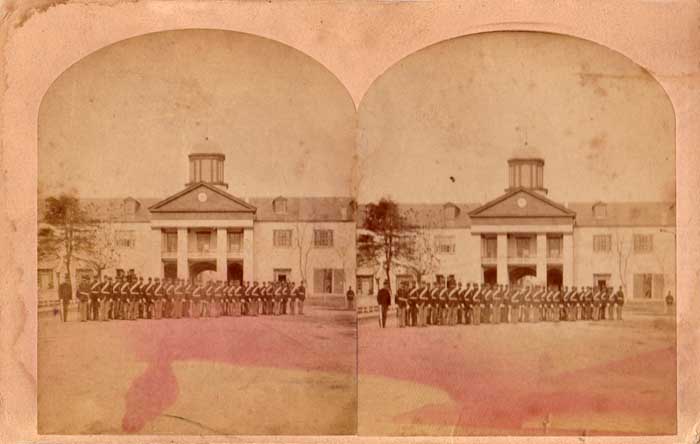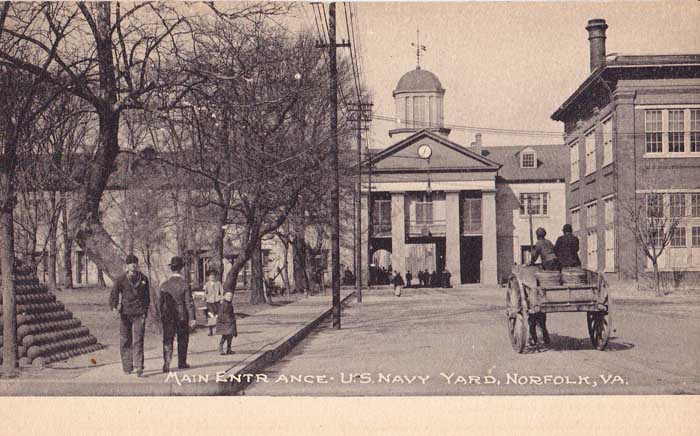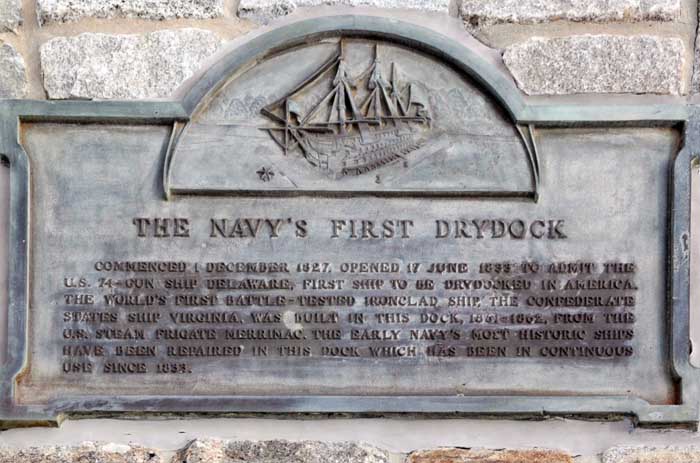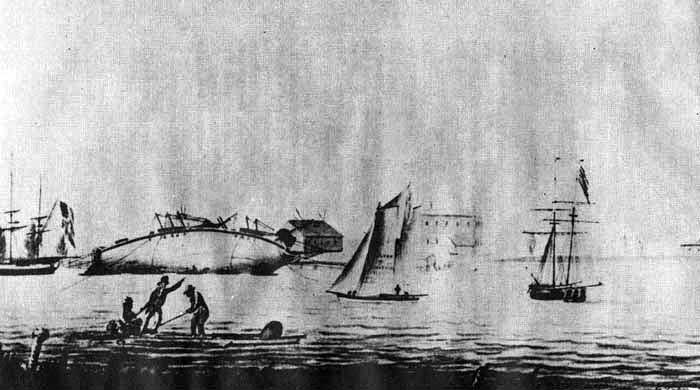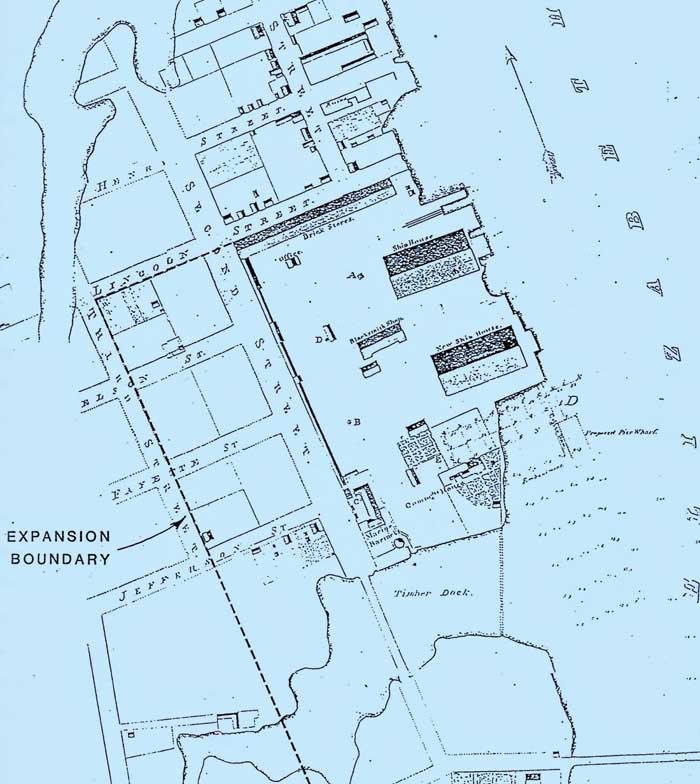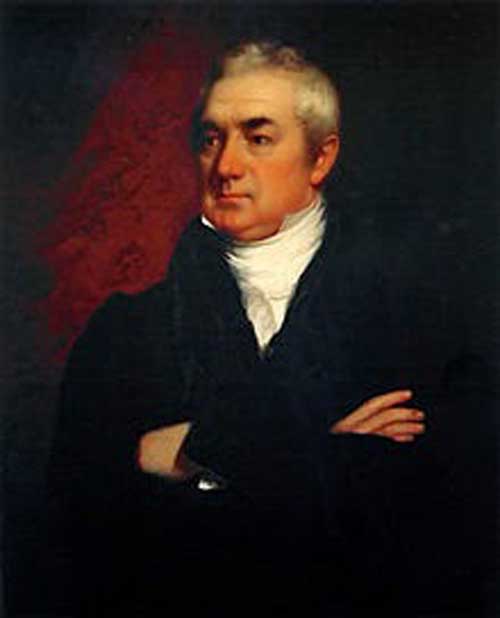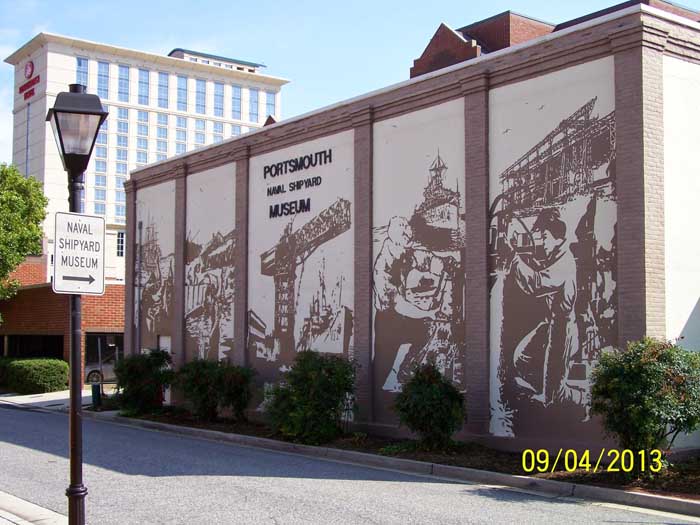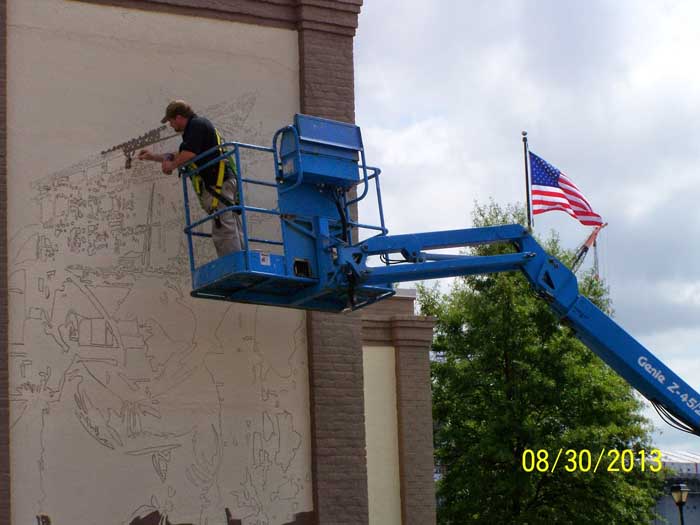
Marcus W. Robbins, Historian & Archivist
Copyright. All rights reserved.
Gosport Shipyard – U. S. Navy Yard, Norfolk ~ First Accomplishments (1794-1862)
On November 1, 2012, as promised, I stated that we would soon revisit some of the "first accomplishments" of our shipyard in celebration of its 245th birthday. This blog will look at several up until the 1860's time period; there will always be future blogs to continue tracing our many historic roots forward. Please enjoy looking back and take pride of these major naval events that took place on the shores of the southern Elizabeth River:
USS CHESAPEAKE
The frigate Chesapeake can trace its history to 27 March 1794 when Congress passed "An Act to Provide Naval Armament". Six frigates were built: United States, Constellation, Constitution, President, Congress and Chesapeake. Also known as frigate "D", the keel was laid on 30 April 1798 then launched on 2 December 1799 with formal commission on 22 May 1800. The Chesapeake was built near the site of the present day Building 74 in the historic north end of the shipyard. It is always interesting to reflect back on the importance of Gosport's physical location for the construction of wooden ships from the day of sawpits to the rigging of sail. In 1794 the state of Virginia leased this riverfront property to the young United States government, the same formerly belonging to the British agent Andrew Sprowle due to its superior location. Chesapeake will always be remembered as one of President George Washington's first six frigates and namesake of a local Virginia city.
USS Chesapeake (Naval History & Heritage Command image NH 59556-KN)
USS DELAWARE & the GOSPORT DRYDOCK
Following the War of 1812, Gosport expanded its shipbuilding capacity in not only physical size of the yard but also in the class of war ships it would be capable of constructing. Delaware had its keel laid in August of 1817 and was launched 21 October 1820, again near the present day site of Building 74 in the historic north end of the shipyard. What made Delaware unique is the sheer size of the vessel being rated as a "74 gun ship of the line"; it was the largest ship to that date constructed at Gosport. Also as a result of "An Act for the Gradual Improvement of the Navy of the United States", passed by Congress, 3 March 1827 there was constructed at Gosport one of two drydocks in the United States, the other being at Boston. Begun in 1827 and finally completed in 1834, the dock at Norfolk is still in use today with only the cassion being repaired or replaced as required. Before the drydock was formally completed it was christened on 17 June 1833 by USS DELAWARE, the first vessel to be dry docked in the northern hemisphere.
USS Delaware entering Gosport stone drydock, 17 June 1833 (traditional image)
USS MERRIMAC / CSS VIRGINIA
The steam frigate Merrimac, 40 guns and which had been under repair at the yard, was burnt to the waterline and sunk on 21 April 1861 by Union forces that abandoned Gosport attempting to destroy valuable warships and industrial shops. While somewhat successful, the effort was not complete. Confederate forces gained control of Gosport as their own and were successful in converting Merrimac into the CSS Virginia by the spring of 1862. Virginia went on to make history at the Battle of Hampton Roads on 8 March 1862 by sinking USS Cumberland and burning USS Congress, then engaging in the first ironclad vs. ironclad with USS Monitor on 9 March 1862 resulting in a draw; thus forever changing naval warfare and making obsolete wooden ships under the power of sail.
USS Merrimac burning at Gosport 21 April 1862 (Circa 1905 postcard. Property of the author)
CSS Virginia conversion at Gosport (Circa 1880's steel engraving. Property of the author)
Battle of Ironclads, March 9 1862 (Circa 1905 postcard. Property of the author)
The site of the modern Norfolk Naval Shipyard has been the home to so many "first accomplishments" that it is impossible to consolidate them all in a single blog. Over the next few months please, check back as we examine the neglect of Gosport regarding post Civil War reconstruction, the eventual expansion supporting the age of steel and steam in the 1880's, then the departure of the Great White Fleet, which would only get us up to 1907! There can be much also written about the unique German Village we hosted in 1915, Norfolk's contributions to the birth naval aviation, vast expansion due to World War I, the battleship modernization program of the late 1920's, the great depression, our awesome industrial output and physical growth during World War II with over 43,000 employees, and forward into the 21st century supporting the nuclear navy because – "history matters".
The Great White Fleet Departs Hampton Roads ~ 105 Years Ago Today, December 16, 1907
Hampton Roads, the world's greatest natural harbor was the gathering and departure point 105 years ago today and bore witness to President Theodore Roosevelt's vision of the largest naval deployment of steam and steel warships in order to project America's strength as a global naval power.
USS Connecticut leading the Atlantic Fleet's Battleships, 1907
(Naval History & Heritage Command image NH 59537)Again, the world's eyes are focused upon eastern Virginia, and the Norfolk Navy Yard gave full support to final preparations in order to sustain this historic journey. In this same harbor where wooden warships were rendered obsolete by the Battle of Hampton Roads in 1862 a short forty-five years later, sixteen of the newest type battleships had gathered after months of planning and shipyard drydock and pier side work at four east coast Navy Yards. With fresh white paint, except for ornate gold gilding on each bow, they were all fully burdened with initial loads of coal to carry them for what would turn out to be a voyage of near 44,000 nautical miles covering twenty port calls on six continents that spanned over fourteen months of time before returning back to Hampton Roads in 1909.
The shear amount of planning and final preparations for such a venture was monumental. As extracted from the Naval History and Heritage Command the following summary is offered:
During September and October 1907 all sixteen of Atlantic Fleet's modern battleships steamed to East Coast Navy Yards for repairs and alterations. Boston worked on four: Vermont, New Jersey, Missouri and Illinois. New York did five: Connecticut, Louisiana, Rhode Island, Ohio and Alabama. Four (Kansas, Georgia, Maine and Kearsarge) received the attentions of the Philadelphia Navy Yard, while the Norfolk Navy Yard performed work on Virginia, Minnesota and Kentucky. The three Norfolk ships had to go north to New York (first two) and Boston (Kentucky) for the drydock phases of their overhauls. This shipyard work was finished by early December and the battleships gathered in Hampton Roads, Virginia, to complete preparations for their forthcoming cruise around South America to the Pacific Coast.The Norfolk Navy Yard, being the home of the Atlantic Squadron well before the modern day Naval Station was established in 1917, no doubt provided untold last minute supplies, coal and various logistical support to the bulk of these sixteen warships in the final days leading up to the Presidential review off of Old Point Comfort on the northern side of Hampton Roads on a bright sunny morning exactly 105 years ago today, December, 16, 1907.
Being the naval collector I am, events such as this mean so much more when you can weave a real person into the very fabric of the story. My artifacts that once belonged to a sailor off of the USS Georgia, Mr. Forest Edward Frost, lend a personal side to what he would experience along with the other 14,000 sailors that made the voyage around the world for what would be later known as – The Great White Fleet. As stated above, the Georgia was assigned to Philadelphia Navy Yard for preparations. While there, Forest has his photograph taken in his sailor suit and tally cap proudly displaying: USS GEORGIA at the Lipp Studio. On the reverse in his own handwriting, he personalizes this photo meant for those he is about to leave behind with the following notation: "ON THE GEORGIA IN 1907 – Forest".
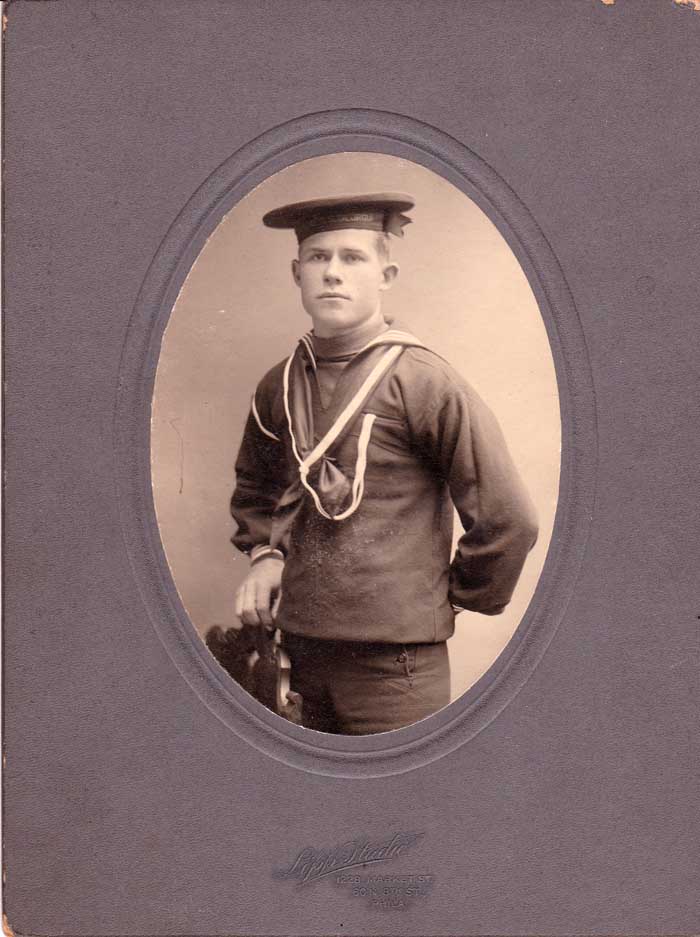
1907 Lipp Studios, Philadelphia, Forest Edward Frost (courtesy of author)
1907 reverse of Forest Edward Frost photograph (courtesy of author)It is a fact of Navy life you are issued identification, uniform, and for these sailors also a ship to live on for fourteen months. Two of the most common items that would have held closeness in the everyday life of our featured sailor from the USS Georgia are shown below. There is no doubt that these items did travel with him around the world and were a part of his life daily
circa 1907 Forest Edward Frost dog tag and belt buckle (courtesy of author)
USS Georgia (circa 1909 postcard courtesy of author)Finally shown above is a look at the USS Georgia, as it and the other battleships appeared when they returned to Hampton Roads as part of the largest battle fleet to ever circumnavigate the globe because – "history matters".
The Sinking and Loss of the USS Monitor ~ 150 Years Ago on December 31, 1862.
The following is a mixture of my own words and personal observations while drawing upon existing postings from both the Naval History & Heritage Command and the National Monitor National Marine Sanctuary websites concerning the USS Monitor sinking, my visit to the Mainers Museum on March 8, 2012, and my attendance today at the Hampton National Cemetery for the dedication of the USS MONITOR MEMORIAL MONUMENT.
USS Monitor, a 987-ton armored turret gunboat, was built at New York to the design of John Ericsson. She was the first of what became a large number of "monitors" in the United States and other navies. Commissioned on 25 February 1862, she soon was underway for Hampton Roads, Virginia. The Monitor arrived there on 9 March, and was immediately sent into action against the Confederate ironclad CSS Virginia, which had sunk and destroyed the USS Cumberland & USS Congress the day before. The resulting battle, the first between iron-armored warships, was a tactical draw. However, Monitor prevented the Virginia from gaining control of Hampton Roads and thus preserved the Federal blockade of the Norfolk area.As I like to provide with each of my writings some obscure lesser known yet direct connection to the old Norfolk Navy Yard, here are a couple of lesser known tidbits of information concerning USS Monitor.
First, tempting as it might have been for Monitor to attack the Gosport Navy Yard before CSS Virginia ever came out, it was deemed too risky to attack for fear of being trapped by a physical blockade once in the narrows of the Southern Branch of the Elizabeth River thus preventing Monitor's escape. Virginia was also able to return to the Gosport drydock for further repairs and alterations after the Battle of Hampton Roads on March 9, 1862, and continued to remain unmolested at home in Gosport due to the same reason. The stalemate continued between the two ships into the spring of 1862, never directly engaging each other again.
Secondly, yet in due time, Monitor did indeed sail down the Elizabeth River, now escorting President Lincoln on the USS Baltimore to observe the Navy Yard in ruins as it smoldered again, this time due to the self-inflicted Confederate torching the day before. The President and his small fleet had just visited the area where Virginia was blown up by her own crew off Craney Island just a few hours prior before sailing past Norfolk and the Gosport Navy Yard the early morning of May 11, 1862. The Monitor most likely turned around and headed north to carry the President back to Washington DC after observing the old stone drydock, the birthplace of the Virginia at the southern extreme of the shipyard.
Monitor remained in the Hampton Roads area and in mid-1862 was actively employed along the James River in support of the Army's Peninsular Campaign. It is at this time various photos are taken of Monitor's officers and crew. Photos have a way to preserve and document naval service on a more personal level. Who were these men, what did they look like and how did they live aboard ship? Today is a day of remembrance to Monitor's men.After a hot summer of routine duty in the Hampton Roads area, Monitor badly needed an overhaul. This work, done at the Navy Yard in Washington, DC, fitted the ship with a telescopic smokestack, improved ventilation, davits for handling her boats and a variety of other changes to enhance her fighting power and habitability. She returned to the combat zone in November 1862, remaining in vicinity of Newport News for the rest of that month and nearly through the next.
In December, Monitor was ordered south to join the blockading forces off the Carolinas. After preparing for sea, on 29 December she left Hampton Roads in tow of USS Rhode Island, bound for Beaufort, N.C. The weather, expected to be good for the entire voyage, stayed that way into the 30th as the two ships moved slowly along several miles off the North Carolina coast. However, wind and seas picked up during the afternoon and turned to a gale by evening. The Monitor labored heavily as she neared Cape Hatteras, famous for its nasty sea conditions. Water began to enter the ship faster than the pumps could expel it and conditions on board deteriorated dangerously.
Shortly before midnight, it was clear that Monitor was in grave danger. Her steam pressure was fast failing as rising water drowned the boiler fires. The tow line was cut, the anchor dropped, and distress signals were sent to the Rhode Island. Boats managed to remove most of the ironclad's crewmen under extremely difficult conditions, but several men were swept away. Finally, at about 1:30 in the morning of 31 December 1862, the historic Monitor sank. Sixteen of her crew of sixty-two were lost with her.
Loss of the "Monitor" in a Storm off Cape Hatteras, December 30th, 1862. – Gallant efforts to rescue the Crew by the "Rhode Island".
(Naval History & Heritage Command image NH 51957)
The above line engraving was published in "The Soldier in Our Civil War", Volume I, page 248. It shows USS Monitor sinking at left with a boat picking up crewmen as USS Rhode Island stands by in the right background firing rockets.
The Monitor shipwreck was discovered in 230 feet of water approximately 16 miles off of Cape Hatteras in 1974. It has been now designated the nation's first national marine sanctuary. In August of 2002 the turret was raised, then taken to its new home at the Mariners Museum in Newport News, Virginia, for long term conservation and display. It is well worth the trip and you will also wish to return again in future years to observe their continuing progress of bringing the USS Monitor back to life.Of those sixteen crew members that perished, two sets of remains were found during the recovery effort. The remains of these two unknown sailors currently reside with the Joint POW/MIA Accounting Command in Hawaii. NOAA is making every effort to identify these sailors and to have them interred at Arlington National Cemetery in 2013.
When I toured the Mariners Museum this year on March 8, 2012, to celebrate the 150th anniversary of the Battle of Hampton Roads, I was privileged to be in the right place at the right time just after opening and before the crowds got there. I was able to view up close the Monitor's famous gold ring as it was taken out of its display case by the staff. It was an honor for me to be within inches of such an iconic historic artifact that day. I will forever realize and appreciate the very personal and yet tragic side to this story, as there were two sets of human remains recovered in the turret. Now it wasn't just about the ship but about the men that sailed, operated and ultimately gave their lives for USS Monitor.
On Saturday, Dec. 29, 2012, NOAA's Office of National Marine Sanctuaries, together with the U.S. Navy and the U.S. Department of Veterans Affairs, dedicated a memorial to honor the USS Monitor and the memory of the 16 sailors who died that night the Monitor sank. Placed in the Civil War section of Hampton National Cemetery, located on the Hampton University campus, the monument memorializes the iconic vessel and the heroic efforts of the brave men who served their country.
Memorial to honor the USS Monitor and the 16 sailors who died when the ship sank.
(Photo taken by Marcus W. Robbins at dedication ceremony on December 29, 2012)
Wreath to honor the USS Monitor and the 16 sailors who died when the ship sank.
(Photo taken by Marcus W. Robbins at dedication ceremony on December 29, 2012)It is so important now 150 years later to remember both the CSS Virginia and the USS Monitor for each of their unique designs and contributions that changed naval warfare forever. It is equally important for us to pause and remember the men that served upon each ship and even gave their lives because – "history matters".
Establishment of the Portsmouth Naval Shipyard Museum ~ 50 Years Ago on January 27, 1963
This past Wednesday I attended an enthusiastic appreciation of our local naval history at one of the best kept secrets in Portsmouth. Located at 2 High Street is a small simple building that took on a 2nd life 50 years ago this week because on January 27, 1963, it officially opened to house the artifact collections of the Norfolk Naval Shipyard.
The words of prior Public Affairs Officer, Joe Law best describe:
A much-prized collection of model warships, old weapons, flags, books and other memorabilia is displayed in the Naval Shipyard Museum located near the foot of High Street in downtown Portsmouth.
More than a thousand artifacts that reflect the long and distinguished history of the Norfolk Naval Shipyard are housed in the museum, which is open six days a week. Most of the collection was assembled in the shipyard by Marshall Butt, shipyard historian and director of the Technical Library, and displayed for many years in Building 33.
Rear Admiral Homer N. Wallin initiated the collection and display of shipyard documents and artifacts after taking command in 1949. The shipyard's museum opened in March 1950.
The original collection, which was loaned to the city during 1961, has been expanded by additional Navy material. The museum's content also includes many items illustrating the city's history.
In the simplest of terms, this is a place where you can see up close historical items that tell the story of the birth of our shipyard from its earliest days to present. As shown in the photo below there was much excitement on opening day as the collaborative efforts between the Navy and the City of Portsmouth were finally realized. Now also the general public could share and gain both education and cultural awareness from the local hometown naval artifacts.
Portsmouth Naval Shipyard Museum, Opening Day ~ January 27, 1963
(Photo courtesy of the Portsmouth Naval Shipyard Museum)So what was the real motive to move the collection from out of the shipyard? From what I can gather, it is really no different today than in time past, a lack of adequate space. On one hand the collection was far larger than the space allotted to display in 1949, and as shipyard missions grew ever more complex it became painfully obvious that prime 1st floor administrative space was needed to be reclaimed at Building 33. The location of the former museum is where the large open assembly meeting room is located, northern end on the 1st floor of Building 33.
Portsmouth undertook major investments of their waterfront in the 1960's and the Portsmouth Naval Shipyard Museum became an anchor at the end of High Street, a focal point of success. In 1967 the Coast Guard's Lightship Portsmouth would sail no more as it became permanently berthed, surrounded by concrete and turf to become the newest nautical attraction along the new seawall that was completed in the early 1970's.
Portsmouth Naval Museum Postcard (circa 1965)
(Courtesy of Marcus W. Robbins)Five interesting notes about the postcard view shown above:
1. The drone Polaris missile and associated water fountain was for years the object of countless pranks that involved boxes of soap powder are no longer there but; who says you can't have clean fun in P Town? The drone was later taken to Trophy Park for a display.
2. The flags display the heritage of the Norfolk Naval Shipyard - "Under Four Flags".
British
Virginia
United States
Confederate States3. The sidewalk cannon artifact displays are different today than found on the post card view as time progressed forward. In the 1990's the modern ferry slip was excavated up to the site of the old fountain and much new construction was accomplished placing a large multi-story waterfront condo along the seawall.
4. The Lightship Portsmouth has not yet been permanently docked and landlocked (circa 1967).
5. The 1917 USS MISSISSIPPI ship bell at the right of the front door was still being polished.
The Portsmouth Naval Shipyard Museum website is full of upcoming events and related links as found here:
http://www.portsmouthnavalshipyardmuseum.com/naval_shipyard/about.htmlThe museum takes pride to actually tell three local stories under one roof. Those stories honor both the Naval Shipyard and the city of Portsmouth as partners growing up so connected to each other for well over 200 years and also the local military. The Portsmouth Naval Shipyard Museum offers a unique perspective on U.S. history, from Colonial to Civil War times and beyond. You’ll find beautiful ship models, uniforms, military artifacts and exhibits portraying life in 18th, 19th and 20th century Portsmouth, Virginia.
When I first began to be associated with the museum and realized that I had a passion to preserve and tell the story of Norfolk Naval Shipyard, I introduced myself to long time Curator, Alice Hanes. I remember that day well, July 10, 2006, as I purchased a couple of small matted pictures and had her sign and date the rear of them (all good historians document memorable events). To me, Alice provided that physical link back to Marshall Butt who first had the foresight to assemble the original collection because soon after, she passed the torch forward to my good friend, the current Portsmouth Naval Shipyard Museum Curator, Mr. Corey Thornton.
50th Birthday Celebration of the Portsmouth Naval Shipyard Museum.
(Photo taken by Kristi Britt on January 23, 2013)Whenever I give a new employee a tour or simply answer a co-worker's question about the history of the shipyard, I try to slip in my own question, "Have you ever been downtown to the museum at the end of High Street?" More times than not, sadly it is responded with "I didn't know it was there". As I started out this writing, don't let #2 High Street be one of the best kept secrets in Portsmouth anymore because – "history matters".
See, Touch & Learn of Gosport Navy Yard & Portsmouth's History 1860-1865 This Weekend ~ August 17, 2013
When I last wrote in my "History Matters" Blog #25 it was about the celebration of the 50th anniversary of the opening of the Portsmouth Naval Shipyard Museum which originally opened to house the artifact collection of the Norfolk Naval Shipyard in 1963.
Then, as now, I say to people that this small unassuming building at # 2 High Street is one of the best kept secrets in Portsmouth. Often people ask me about being able to learn of the early history of the Gosport Navy Yard from its early beginnings and through it’s almost 246 years of continual operation under four flags and there is where I point them. My good friend, the current Portsmouth Naval Shipyard Museum Curator, Mr. Corey Thornton and his staff do a wonderful job in conveying not only the shipyard story but also the close association of the shipyard with the City of Portsmouth.
The Portsmouth Naval Shipyard Museum website is full of upcoming events and related links as found here:
http://www.portsmouthnavalshipyardmuseum.com/naval_shipyard/about.html
You cannot tell the story of one institution, shipyard or city without making reference to the other. At no other time in past history is this more evident than as we look back upon the Sesquicentennial of the American Civil War, roughly the years of 1860-1865.
As a way to both honor and in commemoration of the effects of the Civil War period had upon the local citizens working in the Gosport Navy Yard and living in the City of Portsmouth the Portsmouth Art & Cultural Center is proud to present My Heart Beats For Peace upstairs in the Court House Gallery continuing through August 25, 2013.
I provide for you here the official exhibit description of the My Heart Beats For Peace program:Portsmouth's Civil War Home-front
In commemoration of the Sesquicentennial of the American Civil War. Drawing from regional history and local collections My Heart Beats for Peace explores the impact of the war on the homefront of Portsmouth, Virginia. The exhibit examines Portsmouth in the early days of the war, when Virginia seceded and became part of the Confederate States of America. The exhibit then concentrates on the Federal occupation of Portsmouth and the area, and how occupation affected the community from 1862 to 1865. Through artifacts such as daguerreotypes, carte-de-visites, letters, camp goods, tools, military equipment, uniforms and dresses the exhibit offers to take you back into wartime Portsmouth. My Heart Beats for Peace also offers a historical glimpse across time into the lives of its people, who despite their differences in race, gender and social status were forever changed by the Civil War.
The following pictures are from the Naval Shipyard Museum website and should give readers of "History Matters" a peek at the professional level of presentation concerning the My Heart Beats For Peace exhibit. This is something that should not be missed!

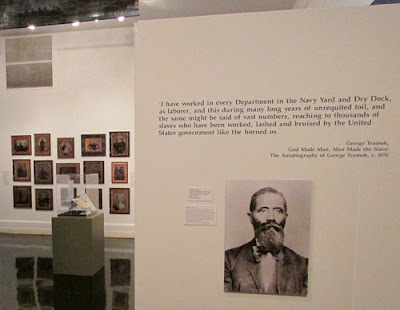
(Courtesy of Portsmouth Naval Museum)
As an aside, and providing a very small part, I contributed three original handwritten letters, dated from within the walls of the shipyard, two of them by a Union solider in May of 1862 and one from the yard’s Naval Constructor in 1864 that are also on display in My Heart Beats For Peace. As shared before in prior blogs, early Gosport or Norfolk Navy Yard in this time period is my passion.
See, Touch & Learn of Gosport Navy Yard & Portsmouth's History 1860-1865 This Weekend ~ August 17, 2013
At the Court House Gallery within the first floor display hall, this Saturday only, I along with a wealth of other local collectors shall display actual period items from within our personal collections that recognize impact of the Civil War for both the Navy Yard and Portsmouth area. There will be many tables set up with original artifacts this coming weekend.
With the My Heart Beats For Peace exhibit upstairs and this special one-time only local gathering of historical personal Civil War collections downstairs this is shaping up to be an event to where you can see, touch and learn from a very important time period 150 years ago and how it ever affected the local area because – "history matters".The Great White Fleet Departs Hampton Roads ~ 106 Years Ago, December 16, 1907.
This coming Monday shall mark the 106th anniversary of the greatest show of naval strength our nation had assembled from since declaring its independence from England 131 years prior. Sixteen of the nation’s finest warships would depart on December 16, 1907, and circumnavigate the globe, a voyage of nearly 44,000 nautical miles covering twenty port calls on six continents that spanned over fourteen months of time before returning back to Hampton Roads on February 22, 1909.
The port of Hampton Roads has always been considered central to the settlement and advancement of our nation. This fact is not lost on its military importance also.
Beginning with Jamestown in 1607 this area was strategically recognized as important because of its many natural advantages; deep calm water, mild climate and abundance of harvest to support the new colony.
The roadstead also served as a natural divide for Union and Confederate forces becoming central to each side during the earliest part of Civil War in 1861 and later in March of 1862 as it bore witness to the end of wood and sail warships with an event that would ever tie "The Battle of Hampton Roads" into naval conversation as a milestone event.
Now in 1907 Hampton Roads would again become the focal point to bear witness to President Theodore Roosevelt's vision of the largest naval deployment of steam and steel warships assembled in order to project America's strength as a global naval power.
Roosevelt was a firm believer that America’s interests abroad could only be protected with the ability to project naval power to anywhere around the globe. In 1907 it was general knowledge that the fleet departing Hampton Roads left under peaceful terms; a simple training mission to the West Coast. While held close with only a few knowing of Roosevelt’s real intention till the end of the first day of sailing the secret then became factual; that after the West Coast arrival that the fleet would then cross the Pacific, transit the Suez Canal, sail through the Mediterranean Sea, cross the Atlantic and again arrive back at Hampton Roads. Nations lined up offering to become ports of call and the America’s ability to project its influence through naval diplomacy began. Roosevelt later reflected about this cruise "the most important service that I rendered for peace".
USS Connecticut leading the Atlantic Fleet's Battleships, 1907
(Naval History & Heritage Command image NH 59537)It is important to recognize that this undertaking was supported by the nation’s East Coast public yards; those principally being located at Norfolk, Philadelphia, New York and Boston. Each location was tasked with taking various specific ships and performing repairs to place them into top shape in very short order. The common thing that each ship received at the conclusion of their individual availabilities was an entire fresh coat of white paint with the only exception being their bows, painted gilded gold.
The shear amount of planning and final preparations for such a venture was monumental. As extracted from the Naval History and Heritage Command the following summary is offered:
During September and October 1907 all sixteen of Atlantic Fleet's modern battleships steamed to East Coast Navy Yards for repairs and alterations. Boston worked on four: Vermont, New Jersey, Missouri and Illinois. New York did five: Connecticut, Louisiana, Rhode Island, Ohio and Alabama. Four (Kansas, Georgia, Maine and Kearsarge) received the attentions of the Philadelphia Navy Yard, while the Norfolk Navy Yard performed work on Virginia, Minnesota and Kentucky. The three Norfolk ships had to go north to New York (first two) and Boston (Kentucky) for the drydock phases of their overhauls. This shipyard work was finished by early December and the battleships gathered in Hampton Roads, Virginia, to complete preparations for their forthcoming cruise around South America to the Pacific Coast.
The Norfolk Navy Yard, being the home of the Atlantic Squadron from the early 1800’s well before the modern day Naval Station was established in 1917 no doubt provided untold last minute supplies, coal and various final logistical support to the bulk of these sixteen warships in the final days leading up to 1907 departure.
U.S. battleships steaming out to sea. Hampton Roads Va.
1907 Underwood & Underwood Stereoview #S145 (courtesy of Marcus W. Robbins)Teddy Roosevelt reviewing off of Old Point Comfort on the northern side of Hampton Roads upon the presidential yacht Mayflower observed that day the crews of sixteen warships manning the rails with "bully" pride. Their passing in a long single formation while keeping 400 yards apart produced an almost 4 mile long armada that would later be nicknamed "The Great White Fleet".
The cruise also became a proving ground of sorts to determine both physical and tactical conditions of the warships after such a long voyage because as Roosevelt stated "I want all failures, blunders and shortcomings to be made apparent in time of peace and not war". Although the cruise produced no major breakdowns it served as to bring technical changes with ship design concerning hull design and gunnery arrangement. It underscored the dependence upon foreign coaling stations and the need to convert warships into oil as a primary fuel. Also improvements were made below decks concerning ventilation and crew living spaces.
Sailor Parade at Norfolk, VA. Feb. 27, 1909
After the Return from the "Trip Around the World"
1909 Postcard (courtesy of Marcus W. Robbins)Finally, shown above is a look at some of the crew members in Norfolk Virginia after their return to Hampton Roads as part of the largest battle fleet to ever circumnavigate the globe. They, some 14,000 strong represented from their naval service over the prior 14 months a renewed sense of national pride and a positive upturn for the United States Navy in order to firmly establish itself as a global force for good because – "history matters".
Looking Back on Three Historic Snows at the Norfolk Navy Yard.
Snow. So peaceful, quiet and pure.
Snow. A stranger here at the Navy Yard? Not really. It floats down from the darkened skies every few years as it did this past evening. Most of us are home today waking up to our own winter wonderland.
While I don’t have a photograph of this 2014 snow visit at the modern Norfolk Naval Shipyard, I can share with you a look back at three prior snowfalls. These beautiful events were documented long ago by prior staff using a box camera supported on a wood tripod stand. Glass plates are a long lost form of photography. These images are from February 1901, January 30, 1904, and March 21, 1908.
Enjoy the following (5) photographs taken over 100 years ago at the old Norfolk Navy Yard.
Photo #1 ~ Looking North West, Trophy Park
(Historic Norfolk Navy Yard Glass Plate Collection, #126 taken in February 1901)
Photo #2 ~ Warrington Avenue Looking North West at Trophy Park
(Historic Norfolk Navy Yard Glass Plate Collection, #314 taken on 1/30/1904)
Photo #3 ~ Looking West at Quarters A
(Historic Norfolk Navy Yard Glass Plate Collection, #315 taken on 1/30/1904)
Photo #4 ~ Barron Street Looking West at Building 11 & Trophy Park
(Historic Norfolk Navy Yard Glass Plate Collection, #548 taken on 3/21/1908
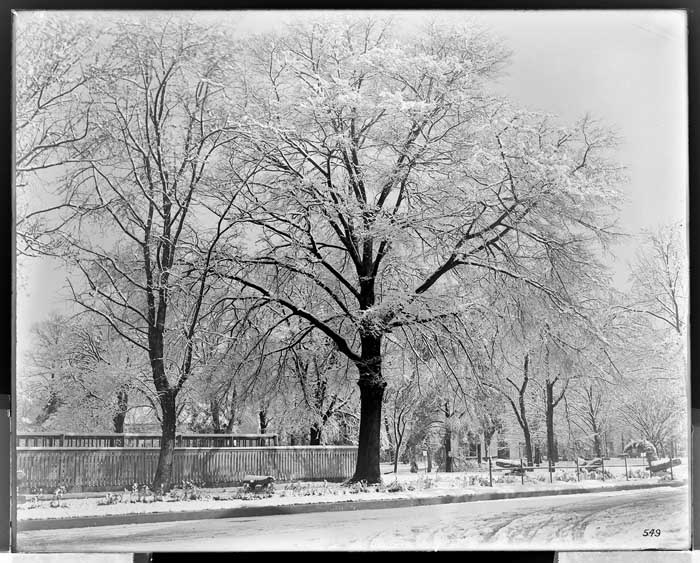
Photo #5 ~ Looking North East at Building 13 & Trophy Park
(Historic Norfolk Navy Yard Glass Plate Collection, #549 taken on 3/21/1908)
Snow might cover everything yet quality always remains the same at its core. I hope you have enjoyed these historic views of common locations you pass by in a daily rush with a new appreciation of the long and proud heritage this institution provides with its unwavering quality service to our Navy.
The forces of nature also remain constant - snow will always be with us, we just never know when. Now just sit back and enjoy these rare snow visits because –"history matters".
Looking Back at the Birth of the Downtown Tunnel in 1952.
News flash: Today 2/1/14; tolling has returned on both the Elizabeth River Downtown and Midtown tunnels. There is a good chance if you are a middle-aged adult reading these words you will be deceased before the current tolling plan is lifted in 2070.
There have been massive gallons of ink spilled and many a ream of paper used debating the merits and current state of this new round of construction and transportation improvements, yet I wish to only offer you a quick historic glimpse of what began in May of 1952, some 62 years ago this spring as our first area tunnel was born to great celebration.
Tolls have always been a necessary evil to construct certain capital projects. Such toll based funding was necessary with the Norfolk-Portsmouth Bridge Tunnel, operated by the Elizabeth River Tunnel Commission. The entire complex was completed and opened to traffic in May 1952 at a cost of twenty-three million dollars.
Norfolk - Portsmouth Bridge Tunnel Postcard (circa 1952)
(Courtesy of Marcus W. Robbins)Crossing under the Southern Branch of the Elizabeth River with the tunnel portion (93 feet under the surface) and over the Eastern Branch of the Elizabeth River with the newly constructed Berkley Bridge portion, this modern feat of engineering connected the cities of Norfolk and Portsmouth and sealed the fate of the automotive ferry system which ceased to exist after 1955.
Portsmouth Entrance Bridge Tunnel Postcard (circa 1952)
(Courtesy of Marcus W. Robbins)As an aside note, there were even two different passenger ferry services arriving directly to the docks of the Navy Yard during World War II. One ferry came from York Street at Norfolk and one came from the Saint Helena Annex. Both of these ferry services supported the movement of large amounts of people quickly to and from the Navy Yard without the congestion of additional automobiles.
Speaking of quickly moving across the watery divide, it is interesting to note the attached scan of a Norfolk-Portsmouth Tunnel pamphlet from 1967 which touts the claim "cross the Elizabeth River in 3 minutes". Also, in regard to the image on the pamphlet, I call your attention to the artwork seal that celebrates the Norfolk Naval Shipyard at 200 years of service, 1767-1967. It also celebrates the first battle of ironclads in Hampton Roads, 1862. While it is well known that the Virginia sailed down the Southern Branch several times, most folks never have been aware that the USS Monitor also sailed this same branch as she reviewed the smoldering ruins of the Navy Yard on May 11, 1862, while escorting the USS Baltimore that was carrying President Lincoln before returning to Washington. We live and work along such a historic waterway.
Norfolk - Portsmouth Bridge Tunnel Pamphlet (circa 1967)
(Courtesy of Marcus W. Robbins)A second tunnel crossing was opened to traffic in 1962 to support additional capacity between the cities of Norfolk and Portsmouth and was known as the Midtown Tunnel. It is a fact of life in Tidewater Virginia, if you travel any distance you will encounter a bridge, a tunnel or sometimes both. We live and work in such a diverse geographical area.
Downtown Toll Plazza on Norfolk Side Postcard (circa 1960)
(Courtesy of Marcus W. Robbins)While tolls escalated over time, most of us remember the final cost of crossing either one of these tunnels. It was a simple 25 cent prepaid ticket you could purchase in booklet form or better yet you could also enjoy the personal interaction of passing your money to a real human at a toll booth (see scans above and below). I’m not saying it was fast but at least you had a sense of personal accomplishment after you passed the toll booth and most times they said "thank-you".
Distance View of Navy Yard Crane & Building Ways Postcard (circa 1960) & Toll Ticket (circa 1978)
(Courtesy of Marcus W. Robbins)By the late 1980’s the Downtown Tunnel became part of Interstate 264 along with construction of a second Berkley Bridge and the tolls became a memory. By 1991 Interstate 464 was connected on the Norfolk side and traffic capacity increased, passing easily and quickly between Norfolk and Chesapeake Virginia.
Now why are the area tunnels and river crossings important to the Norfolk Naval Shipyard of today?
Both our core civilian and contractor workforce population, our military guests that are having their ships repaired and modernized at our world class facilities and untold commercial vendors sending us supplies and the tools of our trade most times encounter the fact they must cross the river. Our transportation network is much like the human circulatory system, it pumps blood and life into the local economy. We do not live where we work, we must travel.
With the establishment of a ferry system that began between Norfolk and Portsmouth in 1636 as a simple skiff to the large automotive ferry that lasted till 1955, there has been the challenge to move both goods and people across the Elizabeth River.
With the modern bridges and tunnels we utilize today, there shall always remain that need (no matter what the cost) to get to the other side because –"history matters".
Looking Back at the 2nd Burn of the Navy Yard ~ 153 Years Ago Today
If you are a regular reader of this blog you no doubt followed the progression and build-up to not only the 2nd burn of the Gosport Navy Yard on April 21, 1861, by the Union forces but the instant industrial base of ship building and repair operations gained by the Confederates.
All without a single shot being fired yet for the decisions ultimately made by Shipyard Commander Charles S. McCauley to torch the yard and destroy the remaining ships over the night of April 20 and into the daylight of April 21, 1861, influences directly the duration of the Civil War.
These events were covered in great detail beginning with my "History Matters" Blog #4 written on March 4, 2011, and progressing in a specific cadence of what was transpiring exactly 150 years ago and concluding with my "History Matters" Blog #10 written on June 22, 2011.
These specific blogs as well as the other historical events leading up to the Battle of Hampton Roads and then 3rd burn of the Gosport Navy Yard may be found upon my main website under the "History Matters" link found here:
http://www.usgwarchives.net/va/portsmouth/shipyard/nnytoc.html
To pay respect to the memory of what happened 153 years ago, I have blended excerpts from some of my prior blog passages mentioned above to give a concise summary for the reader of the 2nd burn of the Gosport Navy Yard. It is my hope that today’s visitors walking around the surviving structures and the very grounds that were once covered with ash would gain an appreciation of how historic an event this was thus I share the below:
In order to really appreciate our shore-based history today, I want to now share of what buildings and facilities were in place before our shipyard suffered its second of three major fires, as we approach the 150th anniversary of the inferno. Gosport would soon become a smoldering victim of the match under the Union force’s evacuation on April 21, 1861.
Wood, by its very nature, is temporary, thus buildings become wounded by decay or completing their circle of life in a few decades are in time replaced by other structures. Brick, a more permanent and lasting material, is generally found devoted to more important structures depending on the application and can under the right conditions mark their age by a century or more. Any building can be damaged by the external forces of nature - rain, wind and flood such as are found on the shores of the Elizabeth yet nothing is completely safe from FIRE.
Towering along the waterfront were the massive ship houses "A" and "B" of which there are no known photographs, but are shown in their pre-destruction service in an 1861 engraving contained in my prior blog. Soon they were also wrapped in flames that were seen for miles, marking a new chapter in Gosport’s rich story.
Officer quarters provided the Shipyard Commander and other Navy Yard Officers a place of private residence on station. Quarters A, B, C, D & E were all constructed in the 1830’s. For untold reasons lost to time neither side in 1861 or 1862 set fire to these grand architectural structures of which we can be thankful for today.
In 1851 a grand entrance gate was constructed flanked by an imposing set of wings, along the northern face of the yard. Today we know this area as Buildings 19 and 51, and the main formal center structure survived till the outbreak of World War 1, to later become what we know as Gate 3. Take time, walk Lincoln Street and observe the effects of fire damage to the upper brickwork as the wood roofs burnt off each of these buildings.
The below paragraph is taken from the H. W. Burton’s 1877 book – THE HISTORY OF NORFOLK, VIRGINIA.
On Saturday night, April 20th, 1861, the Gosport Navy-yard was evacuated by the U. S. Government troops. General Taliaferro, commandant of the Virginia militia at this place, made a demand upon Commodore MaCauley for a surrender of the Government property at the yard, which was refused – the Commodore assuring General T. that nothing would be removed and no vessel should leave the yard without due notice being given him. This assurance quieted our people for a while; but in short time it was observed that the hands in the yard were engaged in "cutting down the shears, (which fell across the Germantown), scuttling the vessels, spiking the guns and destroying everything they could lay hands upon."
The following provides summary as given in testimony to the select committee of the Senate appointed by resolution of the 25th of July, 1861, that was formed to inquire into the circumstances attending the destruction of the property of the United States at the Navy Yard at Norfolk.
On the 18th of April, Captain Paulding was sent to Norfolk with written instruction to take command of all the naval forces there afloat, to defend the property of the United States, repelling force by force, and, if necessary, to destroy the vessels and property there to prevent them from falling into the hands of the insurrectionists, or those would wrest them from the custody of the government.
He arrived at the navy yard at about 8 o’ clock in the evening of the 20th of April; he had at his command all the vessels of war belonging to the United States, and fully one thousand effective men, viz: one hundred marines, taken at Washington on board the "Pawnee" in which vessel he went to Norfolk, the crew of the "Pawnee" of one hundred men, Colonel Wardrop’s regiment of Massachusetts volunteers, consisting of three hundred and fifty men taken on board the "Pawnee" at Fortress Monroe, three hundred and fifty men on board the "Cumberland, " and at least one hundred and fifty marines and sailors at the yard on the receiving ships.
Captain McCauley was highly censurable for neglecting to send the Merrimac from the yard as he was ordered, and also for scuttling the ships and preparing to abandon the yard before any attack was made or seriously threatened, when he should have defended it and the property instructed to him, repelling force by force, as he was instructed to do if the occasion should present itself.
A summary of the vessels at Gosport is provided here:
There were at the Navy Yard at that time, the sloop-of-war Cumberland, 22 guns, in commission, with a full complement of officers and men on board; the sloops-of-war Plymouth, 22 guns, and Germantown, 22 guns, and the brig Dolphin, 6 guns, almost ready for sea; the steam frigate Merrimac, 40 guns, almost ready for sea and undergoing repairs; the line of battleship Pennsylvania, 120 guns, in commission as a receiving ship, with considerable crew on board, and the 74-gun ships Delaware and Columbus, and the frigates Raritan, Columbia and United States, dismantled and in ordinary. The force of sailors and marines on the various vessels and at the Navy Yard was probably about 600, well-armed and abundantly supplied with ammunition. The Plymouth, Germantown, Dolphin and Merrimac were lying alongside the wharves and men working on them. The Delaware and Columbus were at a wharf at the southern end of the yard, and might have been considered in "Rotten Row" a term applied to vessels for which the Government no longer has any use.
In closing, many reams of paper have been written by others before me of the events that transpired over the evening of April 20 and into the morning of April 21, 1861. Gosport would now fall victim to the match for the second time. The flag would change from the Union stars and stripes to that of the State of Virginia by daylight of the 21st, all without a single shot being fired because –"history matters".
Historical Events Do Tell a Story at the Norfolk Naval Shipyard
As a historian and archivist attempting to tell the story of our great institution, I am often approached by both new and old employees wishing to know more about where they work. It is an honor that I don’t take lightly as to portray our historical past accurately is to lay the groundwork for our future. To read and recite facts coldly is one thing, but to be able to tell our story often from memory and point out a specific building, area of grounds on the modern shipyard, a certain set of conditions and then to be able to paint a picture in the employees mind of "that’s where they did this" brings a certain satisfaction when you see their faces. Only then they are able to buy in and own it too.
When you can transform at a personal level the historical events of this shipyard, especially by one on one interaction, and a person can actually see where the event took place, then the teaching and telling of the story is not lost to time and forgotten. It gives them pride of where they work. That is the very purpose of "History Matters" blogs that you can read in their entirety here back from the beginning with Blog #1 on January 31, 2011.
Our Norfolk Naval Shipyard lives on today because of the proud accomplishments of not only its past but its promise of the future. It is so very important that new employees learn of the great milestones we accomplished here on the southern branch of the Elizabeth River, not only for the Navy but for the United States. The one thing I try to tell everyone is history is not just something abstract that happened in the past. The history of our shipyard going into the future depends on you also, the new employee "you must own it".
The historical events story of the Norfolk Naval Shipyard are like a great tapestry; it is woven of many individual fibers all coming together to create something larger. Those fibers begin with our people as they demonstrate pride, knowledge and the craftsmanship of the shipbuilding and repair. Those fibers are the tools used and raw materials that are transformed into ships and equipment. Those fibers are the facilities and buildings that are utilized to bring everything together in order to deliver a world class product.
Norfolk Naval Shipyard delivers world class products as evidenced by our motto – "Any Ship, Any Time, Any Where".
One of the best physical artifact tools for learning and teaching a quick overview of our historical events at the Norfolk Naval Shipyard is the bronze plaque inside of Gate 10. I often take new employees there or advise the more seasoned ones to take time to go read what they have driven past for years. It was erected by the Norfolk Naval Historical Association in 1950 with the very mission of telling our story.
Bronze plaque erected in 1950 (located inside of Gate 10) at Norfolk Naval Shipyard.
Text sourced from "A Brief History" by Marshall W. Butt April 1951.If you read the above text carefully, you shall learn of the four flags this yard has had flown from its flagstaff (British, Virginia, Confederacy & United States) and you shall learn of the three different burns (1779, 1861 & 1862) of the shipyard. From the first dry docking in 1833 of a ship in the United States (USS DELAWARE) our Drydock 1 still remains in operation today a testament to the craftsman that built it. Other facts contained on the plaque highlite the conversion of the ironclad (CSS VIRGINIA) of which was important because it helped changed modern naval warfare, it too can trace its heritage to Drydock 1. The US Navy’s first Battleship (USS TEXAS) and the first aircraft carrier (USS LANGLEY) also were constructed here. Finally the plaque gives the various specific dates that this great institution underwent formal name changes.
I have recently unearthed archival documentation of the 1950 dedication of this beautiful bronze tablet and photos of the event, they too shall be the subject of a future blog because –"history matters".
City of Portsmouth 130th Annual Memorial Day Parade
Monday May 26, was a glorious sunshine filled day. On this day we had the honor to witness our very own Norfolk Naval Shipyard, Shipyard Commander Captain Mark Bridenstine serve as the Grand Marshal of the City of Portsmouth’s 130th Annual Memorial Day Parade. He was accompanied by his wife Shelly.
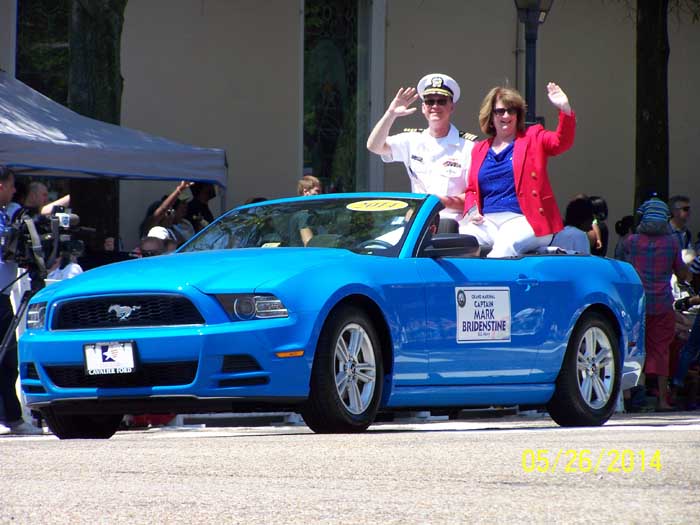
While the weather in eastern Virginia can sometimes be unpredictable this day was bright and sunny. A cheerful festive mood resonated loudly down the street as an estimated crowd of 10,000 attendees lined the sidewalks of High Street for as far as the eye could see. American flags waved and patriotic music played. Red, white and blue was the color theme of the day!
This parade has been a Portsmouth tradition dating back to 1884, a 130 years. To have the leader of the nation’s oldest continuous operating naval shipyard serve as Grand Marshal this year just seemed to be fitting as the modern Norfolk Naval Shipyard can trace its roots back to November 1, 1767 some 247 years. I have often said that the story of both Portsmouth and our Navy Yard must be told together as one cannot be separated without mentioning the other. We live in a proud community, one that has served our nation well. Now, isn’t that what Memorial Day is all about? Providing unwavering military service to the nation is something that comes easily to both of these great institutions.
After the parade nearby there was a touching service to honor the Vietnam War Memorial and the names of local war heroes whose honor of service to their county was acknowledged and their names were read aloud. These folks gave the ultimate sacrifice so that we could enjoy events such as the one today. On this day as it should be every day, we should be proud to be "Americans" and not identified by any other labels. On this day there was an especially strong sense of "united we stand". It should be our hope we never lose this spirit of freedom and not just outwardly display it on 1 day and ignore it the other 364 days of the year.
As quoted by Portsmouth’s Mayor Kenneth I. Wright he proudly provided the following. "Celebrating the 130th Annual Memorial Day Parade in Portsmouth is a long honored tradition of which I am very proud, and it also kicks-off a festive time of tourism and outdoor events within the beautiful and historic City of Portsmouth."
With approximately 65 marching bands, cars, floats, drill teams and other units marching this indeed was a community event. From the youngest to the oldest observing from the sidewalk or of the wide range of participants there were smiles everywhere. A cross section of not only of our community was represented but of our nation. We are a diverse people, again on Monday the only label you could rightfully place on the crowd was that of "Americans".
Did you miss this year’s event? Do you wish you could have made it? Have you ever attended as a child yet lost touch and wish you could make that connection again? Fear not – if I were a betting man I would say just as Spring follows Winter you shall get another chance next May as the Memorial Day observance gears up for consecutive year 131 because here in Portsmouth Virginia –"history matters".
Historic Truxtun, Nation’s First Planned Black Housing Community at 95 Years Old.
I want to thank Mr. Chester Benton, Chairman of the Historic Truxtun Civic League, for allowing me the honor to speak briefly to you all today as we celebrate the 95th anniversary of the formation of the Truxtun housing community.
I am Marcus W. Robbins, an employee at the Norfolk Naval Shipyard for the past 36 & ½ years, that currently serves in the Executive Support Branch as the Command Facilities Manager and in addition fulfills the role as the volunteer Historian and Archivist for the installation. Facilities at the shipyard have been my life and now education and preservation of our great NNSY heritage is my passion.
Historic Truxtun Marker on Portsmouth Boulevard (traveling west)
photo courtesy of Marcus W. Robbins, June 4, 2014The reason why I was asked to speak today is Mr. Benton wanted you all to recognize and appreciate the inseparable history and heritage dating back to 1919 that your community of Truxtun has enjoyed over these 95 years with the Norfolk Naval Shipyard; a true win/win.
Often when I publicly speak or write about the shipyard I make a comment that you cannot speak about one institution (either the City of Portsmouth or in this case the community of Truxtun) without also discussing the influences of the Norfolk Naval Shipyard. You cannot separate one and not talk about the other, like threads in a tapestry.
We all stand here today because of decisions made on the world stage over 100 years ago as war raged in Europe. Take a minute to think about that and reflect to the direct relationship between world events and workload increases to support a war effort. The Navy Yard needed labor and grew practically overnight with vast increase of its industrial capacity due to World War I. Due to the great masses of workers coming in from all over the country and coming very quickly these workers and their families needed decent homes.As taken from the City of Portsmouth’s website, I offer the following historical reference:
Truxtun is the first planned community for African-Americans; it was built as a project of the U.S. Housing Corporation to house shipyard workers. It is significant because Truxtun is among the first government-funded and planned communities in the entire country. The design concept of this district reflects what we today call "new urbanism," a wholly contained community where residents could live, play, and shop within an easy commute to the workplace provided by public transportation. Truxtun was designed with 200 detached and 50 semi-detached 5-room houses on 42 acres.
It was a different time back then, segregation however unfair was a hard cold fact of life. The white shipyard workers lived in their own recently built planned community that we still refer to today as Cradock. Both Cradock and Truxtun were also laid out to where the two communities were totally independent and their workers did not have to cross paths yet they shared the same employer. It has taken decades to change this culture yet it is important that we not forget our past but also mindful not to dwell on its ugliness.
So let us look back on the historical facts of Truxtun and its relationship to the Norfolk Naval Shipyard. Again to accurately reflect history I offer in complete text the official background as transcribed by the Greater Historical Truxtun Foundation:
After World War I in 1918 the Government purchased seventy acres of land for $67,097 from land-owners in Portsmouth and Norfolk, for a planned community of ship yard workers. The land was divided into two parts in order to house the then segregated community into two areas for both black and white ship yard workers. The divided area was called Cradock for Whites, and the area of Truxtun was for Negroes. This was the first and only constructed housing development for Negroes in the United States (U.S. Housing Project #150C.) The town was named after naval commander, Thomas Truxtun. The original design also included plans for a school, church, community house/center, Movie Theater, small railroad station and 35 shops and stores. The area was designed for 253 families, 1265 people, 203 detached homes, 50 semi-attached homes.
As you can see Truxtun was a planned community. Given the chance for home ownership was to give opportunity to become middle class for the Negro worker. The Truxtun community can be proud by being the first in the country to do so. The shipyard gave the residents a decent living wage. With this, independence and the self-sufficiency followed. Truxtun was on the way to middle class by the 1920’s.
So as I conclude I want to revisit my title Historic Truxtun ~ A Community Effort, Strong at 95 Years. Three weeks ago I met the Chairman of the Historical Truxtun Civic League, Mr. Chester Benton. In that 45 minutes we spent walking these streets and looking at the surrounding of modern Truxtun I was impressed with his passion for both his and your community. Passion is not something you force a person to exhibit; it must come from within the soul. You are very fortunate to have such a visionary in Mr. Benton as Truxtun approaches its next milestone at 100 years.
The stories he told me of his growing up here on these streets and the fact you could not get in trouble because by the time you got home the parent network had already relayed the facts so there was no need to make up a story gave a sense of responsibility and pride to do the right thing. Growing up in Truxtun gave many people in this audience today their jump on a successful life. It should be our hope the children growing up today in Truxtun take on that same attitude because – history matters.
The Great Quarters "A" Fire of August 12, 2014
As I opened my email this morning, I was in shock as I viewed a Google news feed link relating to a recent fire at Norfolk Naval Shipyard. It was hard to wrap my mind around what I read and then viewed with the related local video feed. I was watching the Shipyard Commander’s home, Quarters "A" located in Portsmouth, Virginia, upon the grounds of the nation’s oldest continuing operating naval shore establishment in flames. The fire had started around 2:00 in the morning and the events and cause were still unfolding just a few short hours later.
Fire at Norfolk Naval Shipyard ~ Quarters "A" on August 12, 2014
Photo courtesy of Marcus W. RobbinsBeing recently retired as of August 1 this year after serving the bulk of my 36 years, 9 months and 12 day career at Norfolk Naval Shipyard, repeatedly passing by this historic landmark was commonplace. Over my tenure I worked around it as a tradesman, wrote repair specifications for it while in the Public Works Facilities Service Contracts Division for the 5 years I tended to the Family Housing Contract, and more recently informed the recent occupants of little known fun facts concerning Quarters "A" as the yard’s local Historian while also serving as the Command Facilities Program Manager.
To put it simply I have a deep connection with this home even to the point of my wife Jo Ann and I being invited a couple of years ago to a formal Christmas gathering; these are the things that happy memories are made of. Ask anyone whom has ever entered into this home of their feelings and you will understand of the pride that Quarters "A" radiates.
The home is to put it simply, iconic. It is our flagship residence. Quarters "A" stands as a symbol of both elegance and long standing naval tradition. It spans from the rapid growth of the Gosport Shipyard pre-Civil War era up into our modern times. The home was begun in 1837, and the central brick section was first occupied in 1838 by Shipyard Commander Captain Lewis Warrington. That’s right, Quarters "A" is 177 years young and just as strong as the day it was born.
To each and every member of the NNSY Shipyard family both past and present, today should be a sad one. We have lost a part of a good friend, yet from the outward appearance all may not be lost. It should be our hope that this Phoenix shall rise from the ashes and live again.
The remainder of this column shall be extracted passages from the Virginia Historic Landmarks Commission document submitted on November 19, 1974, that nominated not only Quarters A but also the nearby Quarters B & Quarters C to the National Register of Historic Places as follows:
Quarters A, B, and C at the Norfolk Naval Shipyard are handsome and finely crafted examples of Asher Benjamin’s Greek Revival style and illustrate in striking form the pervasive national influence of architectural handbooks among builder-craftsmen of the early-nineteenth century. In addition they are relics, along with their contemporary, the nearby Drydock No. 1, of a period of rapid expansion for the United States and the original Gosport Navy Yard following the War of 1812. After the War of 1812, a systematic effort to expand and improve the facilities at Portsmouth began.
All three of these houses survived the burning of the Gosport Navy Yard by evacuating Union forces in 1861 and another by departing Confederate forces the next year. Well maintained, they continue to serve as residences for high ranking officers of the Yard.
A set of plans for Quarters A, built c. 1837, refer to this building as the Commandant’s House. Larger and more formal than the other two, it is a two-story, Flemish-bond brick structure set on a high basement and covered by a hipped roof with interior end chimneys. The central entry, with its Doric pilasters, plain full entablature, the blocking course, is taken directly from Plate 28 of Asher Benjamin’s The Practical House Carpenter (1830), with minor addition of a transom light. Two curving flights of stairs with original iron railings ascend to a landing at the front-door level. The three-part windows, each consisting of a pair of two-over-two sash flanking a six-over-six window, have ramped white marble lintels with corner blocks. Frame, two-story sun porches with bracketed cornices have been added to the side and to the rear of Quarters A. The latter, with its fantastically carved pilasters and elaborate jig-sawn balusters is a handsome example of its style.
Quarters A’s plan has been slightly modified by the cutting of large arches between the reception rooms. Paralleling its central entrance hall, to the left is a service passage off which the house’s northeast corner is an elliptical stair with eased and scrolled banister, derived from Plate 62 of Benjamin’s Practical House Carpenter. Farther down the passage is a pantry. To the right of the entrance hall is the dining room, and the rear half of the arch with corner block imposts, a central tablet, and symmetrically molded trim. The second-floor plan is similar to the first, but double doors, rather than an open arch, separated the two chambers. Much original detail remains in the house including paneled window reveals, simple marble mantels, and Greek-fret stair brackets.
As Mr. Joe Law stated in his prior writings - of all the residents and recollections over the years, perhaps no entry in A Log and History of Quarters A is more poignant than that of Rear Admiral Brown, who wrote, "May Quarters A continue as long as the shipyard and remain the symbol of gracious living befitting the responsibilities of the shipyard commander, as well as an historical shrine."
Today was a sad day at Norfolk Naval Shipyard if you only look at the plain brick and mortar of a facility, but due to the craftsmanship put forth 177 years ago today’s event - The Great Quarters "A" Fire of August 12, 2014, will in time be looked at in a more favorable light as something that "was" overcome. Just as our NNSY motto is Any Ship, Any Time, Any Where I venture to say that land based events like this are important too because – "history matters".
A Closer Look at the History of Gate 3.
Today I wanted to begin a series of looking back at familiar places all over the modern Norfolk Naval Shipyard. Places we see each and every day but I dare say know nothing about. Facilities not only tell our past story, they are the very structures we depend on to get our job done. I shall utilize long forgotten about outdated original text, maps, glass plate images, film photographs and postcards while I write about these topics. The locations I promise will be very interesting as we still work around them even today. How can you take pride in where you work if you do not know of its great heritage?
Gate 3 – An entrance or access point upon Norfolk Naval Shipyard located at the northern portion of the installation. We have all seen it, and maybe even used it but I dare say never gave a second thought about what history Gate 3 as a supporting facility may have played over time.
Today we view Gate 3 as an opening between the two independent Buildings 19 & 51 that stand guard as a massive two story brick wall along Lincoln Street but it was not always so. This structure can trace it roots back to the pre-Civil War growth of the Gosport Navy Yard. Building 51 was begun construction in 1849 to support Gunners and Sail Makers. It was closely followed in 1851-52 by the completion of Building 19 which housed a Rigging Loft, Armory, Offices and the entrance gateway (Lull 1874). The two were joined with a formal bell tower and presented an imposing formal look.
1859 Gosport Navy Yard Map ~ section of extreme north end
(Courtesy of United States Navy)The structure of Gate 3 is about 163 years old and looks nothing like it former self but still serves basically the same purpose although it was radically modified by the removal of the grand center section in the World War I era to form a traditional roadway with iron gates. Prior to this the actual Gosport main gate were huge wooden doors of massive configuration such as the original gate that is still in place at Fort Norfolk from the War of 1812 era. Still today Gate 3 allows for the movement of people and equipment with the ability to secure the installation from outside intrusion.
Illustration from Norfolk Naval Shipyard Booklet A Brief History (Butt) April 1951
(Courtesy of Marcus W. Robbins)It was out of this same gate that Commander Rodgers and other Union officers departed quickly the flaming inferno all around when the Navy Yard was burned and evacuated as they had attempted to blow up the stone Drydock in the early morning hours of April 21, 1861, they were truly the last ones out. An interesting note before Rodgers was captured he encountered the Confederate forces whom hoisted a rebel flag up the flag-staff of which upon questioning by Rodgers of how they got in, it was conveyed that they came in by the main gate (Lull 1874). As you can see by the map presented above the location of the flag-staff within Trophy Park is yet a stone throw from the main gate.
The main gate complex continued to loom large at the northern end of the shipyard as the post-Civil War era destruction of both Shiphouse "A" & "B" were cleared away. This was before we started to engage on the building of the Battleship Texas and Protected Cruiser Raleigh in the late 1880’s upon the former Shiphouse’s stone ways that were first placed in the 1820’s and their ruins remain under the large asphalt parking lots today.
Illustration from Norfolk Naval Shipyard Booklet A Brief History (Butt) April 1951
(Courtesy of Marcus W. Robbins)One thing I pride myself on is extensively collecting obscure items relating especially to the old Gosport Navy Yard. Below shown is a privately taken oversized stereo-view card that shows our subject gate straight on with a group of Marines in the foreground. This is a one of a kind item but again it tells a long lost story and is from about the 1874 timeframe.
Privately Taken Stereo-View Card circa 1874
(Courtesy of Marcus W. RobbinsOver time the main gate facilities of Buildings 19 & 51 transitioned from working Shops to more administrative in nature. The Shop functions moved out of the Gate 3 complex as the yard expanded to the south. If you look carefully in the middle ground of the below photograph you can see the ruins of the 1850’s stone launching slip. It was upon this same location long before that modern stone ways was in place that the USS Chesapeake and USS Delaware were constructed, the entire area is rich with early naval history. Somewhere around 1911 plans were being made to convert a portion of Building 51 into an Apprentice school to educate the workforce of the ever changing complex business of ship construction and repair.
Post Card circa 1905
(Courtesy of Marcus W. Robbins)In summary all these views are very important to understand how Gate 3 evolved, because – "history matters".
The Earliest History of Drydock 1.
In continuation of the looking back at familiar places all over the modern Norfolk Naval Shipyard I want to give some attention to a facility that can’t even begin to be fully covered in a regular 1,000 -1,200 word edition of "History Matters". With that said over the next few months I will from time to time revisit the modern civil engineering marvel known as Drydock 1; the oldest facility upon this magnificent naval institution and take you from its first formal written conception of January 3, 1825 to its continuous unbroken use today in 2014. Again as stated in my last edition, how can you take pride in where you work if you do not know of its great heritage?
There is so much to know about Drydock 1 but the official plaque near the head of the dock gives summary in fine fashion without any further embellishment as portrayed below.
Drydock 1 Plaque
(Courtesy of United States Navy)Why did we need to construct Drydock 1 at all? Well one must be aware that the concept of modern drydocking was indeed recognized by the Americans as our young Navy was born and grew as a means to efficiently effect under the waterline repairs to vessels yet the concept of placing a ship out of water and into a "dry-dock" goes back to early Greco-Roman practices in the area of Egypt nearly 2,200 years ago. Over the last few centuries the Europeans refined it to the practice we know today.
As with any Government program or new idea several revisions and attempts to fund seem to be the normal course. With the construction of a dry-dock to support the newly formed American Navy Department this was no different. I offer a summary here of dates and order of events found in "History of the United States Navy Yard at Gosport Virginia" (Lull 1874) lost to time and never published in any other contemporary writings but important when considering the whole. Several times from the inception of the Navy Department in 1798 twice appropriations had been made to Congress for the construction of docks, (on the 25th of February, 1799, and on the 3rd of March, 1813) but the amounts appropriated were so small as to be entirely inadequate to the purpose.On the 25th of May, 1824, the Senate of the United States passed a resolution calling upon the Secretary of the Navy for information on the following points:
1st. The expediency, usefulness, economy, and necessity of a dry-dock of sufficient capacity for receiving, examining, and repairing ships of the line.
2nd. The best location for a dry-dock.
3rd. The probable expense of the construction of one of the size mentioned, in a solid and durable manner, with the needful appendages for an advantageous use of it.
The Honorable Mr. Southard, then Secretary of the Navy, in his answer to the resolution, under the date of January 3, 1825, urged in very strong terms the necessity not only of one, but of at least two dry-docks for the Navy, at its then present size. He stated that the only method of examining and repairing the hulls of heavy ships below the waterline, then available, was that of heaving down, an exceedingly slow, expensive, laborious, and dangerous operation, and very unsatisfactory in its results; while, with a dry-dock, work might be performed in a few hours, and at trifling expense, which would take weeks by the process then in use.
I present below an image of operations at Gosport in 1795 depicting the British vessel Thetis being careened to its side for the purpose of undergoing repairs to its hull beneath the waterline. Think of the physical strain to the ship by tugging and pulling it out its element like a stranded beached whale. Yet it is a necessary evil to tend to the unseen conditions. The hull of a ship can be attacked by all sorts of marine growth and once you have a problem, well it can accelerate quickly if not attended to. As a means to prolong a ship’s lifespan it was customary to sheath the hull fully with thick copper sheets fastened by copper nails yet this could only prolong the onset of maintenance and repair.
The "Thetis" Careened and Repairing at Gosport, Virginia
(From a Water-Color by G. Tobin, 1795)
(Macpherson Collection)Further the Secretary endorsed two locations being at Charlestown and Gosport and these paragraphs were included in same report; some facts that remain true even to this modern time.
"At Gosport there is a valuable yard, with improvements; but there is not within its limits so good a position for a dock as upon the adjoining land, which may be bought for a small sum, and add much to the convenience and utility of the establishment already there."
"The Chesapeake and its waters form a first object in every plan relating to the national defense, and somewhere upon them must be placed an important portion of our naval means. Whether our principle depot ought to be there the resolution does not direct us to inquire. But let that question be decided as it may, Gosport must be retained as a repair and refitting station, to which resort can be had in cases of need. Lying behind the strong defenses of Old Point Comfort and the Rip Raps, it can never be unimportant as a naval position. It has numerous surrounding population, deep waters, susceptibility of defense, accessibility at all times, freedom from frost, great facilities in obtaining supplies of materials, and stands at once in the most important and connecting points in that great line of internal intercourse and navigation to which the public attention has at all times been so strongly directed."
As stated in the above Gosport was all about location, location, location yet it also had so many natural and man-made things going for it also. The station would have to be enlarged to support the proposed dry-dock. No longer would Gosport reside inside of the original 16 acres of land first purchased for the sum of $12,000 on January 24, 1801 paid to the state of Virginia. The deed for that transaction was executed on June 15, 1801 by Governor Monroe, by which title and jurisdiction of the property were conveyed to the United States.
Gosport Shipyard and Surrounds (circa 1825)
(Courtesy of United States Navy)As portrayed in the above diagram Gosport would soon benefit from legislation entitled "An Act for the Gradual Improvement of the Navy of the United States" passed on March 3, 1827. The shipyard would grow both to the West and more importantly to the South as additional land was purchased in order to create a place to construct the dock.
Our Drydock 1 can be attributed to the one of the young country’s finest civil engineers at the time, Colonel Loammi Baldwin Jr. Baldwin in his personal profession had made two different trips to Europe studying and examining public works, the last being in 1824. This coincided with a report of the Secretary of the Navy urging the building of two dry-docks in America that was presented on May 25, 1825 thus the die was cast leading to his acceptance of an appointment to oversee the construction of the new dry-docks at the Charlestown Navy Yard in Boston, Massachusetts and the Gosport Navy Yard in Portsmouth, Virginia between the years of 1827 & 1834.
Colonel Baldwin was one of a family of engineers, all more or less distinguished in their profession. He had visited many of the dry-docks of Europe, and was particularly qualified for the work which he afterward preformed of building the docks at Gosport and Charlestown (Lull 1874).
Portrait of Loammi Baldwin Jr. by Chester Harding (circa 1822)
(Courtesy of U. S. National Portrait Gallery)Next month we shall begin to examine the actual November 1827 construction of what would later become the first functional dry-dock in the northern hemisphere on June 17, 1833 because – "history matters".
Navy Yard History Wall Mural at #2 High Street.
One of the best kept secrets in Portsmouth Virginia is located at # 2 High Street. If you want to learn anything the great heritage of the Norfolk Naval Shipyard and have never visited this small building at the foot of High Street adjacent to the ferry landing, well you are missing out on a real treat.
As detailed by its mission statement - The Portsmouth Naval Shipyard Museum researches, preserves and promotes the history of the City of Portsmouth, Norfolk Naval Shipyard, and the armed forces in Hampton Roads. The museum accomplishes its mission by offering exhibitions, publications, lectures and educational programs.
With this edition of "History Matters" I will not write about the inner contents of the museum at this time but please be assured the historical holdings are vast and tell the story of early Portsmouth and its unbroken and deeply intertwined relationship with the Navy. In future writings we shall tour the wonderful artifacts on current display in greater depth.
But for those of you that must know what is behind those doors, a quick peek. The interior portrays a story before the birth of the Gosport shipyard, the revolutionary period, the steady growth into an industrial power as the premier American shipyard prior to the Civil War, the devastating effects of same war upon the local home front, a slow reconstruction period, the Spanish American War expansion, World War I & II outstanding service and forward to the present. There is even a section set aside to show honor to the lightships that operated out of these waters to keep maritime traffic safe upon the seas.
My current intent has been first, a tease by mentioning anyway the interior contents of # 2 High Street, but that is not my focus. It is what hits you as you approach the western exterior façade, a full size wall mural! How can you not miss something 24 feet tall and 65 feet wide?
Completed Wall Mural Painting by Virginia Artist – Sam Welty
(Photo courtesy of Marcus W. Robbins)"We wanted to convey a chronological sense of the history of shipbuilding here in the City of Portsmouth and the Norfolk Naval Shipyard. Considering the mission of the museum - to celebrate the history of the city and the shipyard - we focused on the most common element within the history of both places: shipbuilding. Both places were founded on the industry of shipbuilding and as Portsmouth has grown as a city, it has thrived in large part due to the growth of the Norfolk Naval Shipyard. In addition, the theme also pays homage to all of the smaller shipyards and maritime industries that have come and gone over the years." By Corey Thornton, Curator of History, Portsmouth Naval Shipyard Museum
The Portsmouth Naval Shipyard Museum website is full of upcoming events and related links as found here: http://www.portsmouthnavalshipyardmuseum.com/naval_shipyard/about.html
I promise that after your visit to # 2 High Street you will then understand the various name and major flag changes that have occurred down the river less than 1 mile at our great Norfolk Naval Shipyard. Also if you take good notes you will walk away with a greater clarity of a somewhat confusing issue, the name of the museum located at # 2 High Street being the Portsmouth Naval Shipyard Museum. This museum institution honors a shipyard named for Norfolk that is located in Portsmouth, Virginia. I’ll let that topic be a future column also because it ties into one of the sister Government owned yards up north, the Portsmouth Naval Shipyard located in Kittery on the southern boundary of Maine near the city of Portsmouth, New Hampshire. This naming confusion and controversy goes back a long time.
In Progress Wall Mural Painting by Virginia Artist – Sam Welty
(Photo courtesy of Marcus W. Robbins)I personally was so impressed of what was going on last year I had to make the trip over and observe the work in progress and briefly chat with the artist, Mr. Sam Welty. As you can see this project required precise layout and was completely done by hand and then painted with very small brushes. The impact on the western wall of # 2 High Street is forever changed. We have witnessed a modern artifact of sorts being born last summer. I felt it was fitting to celebrate its one year birthday of completion this current month because – "history matters".
